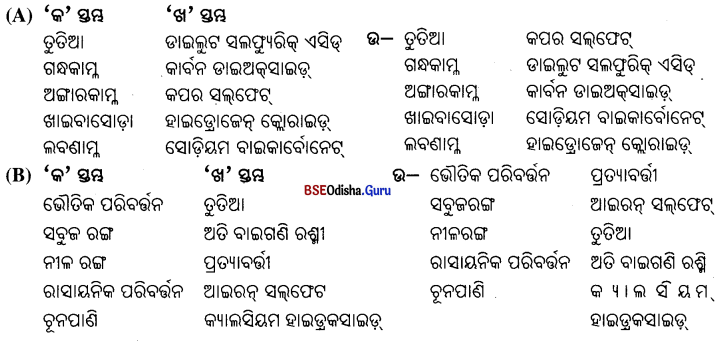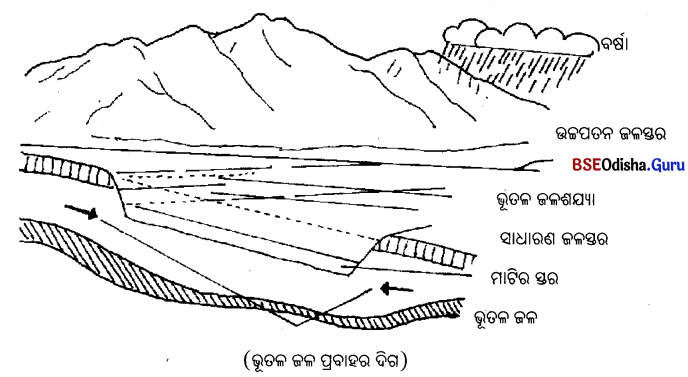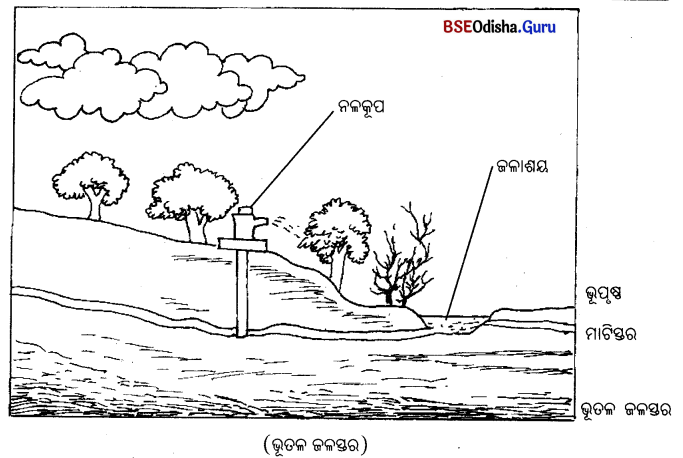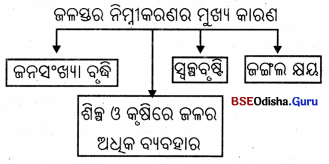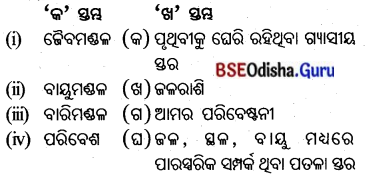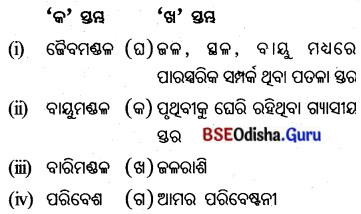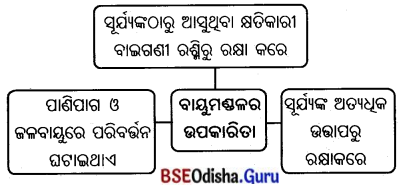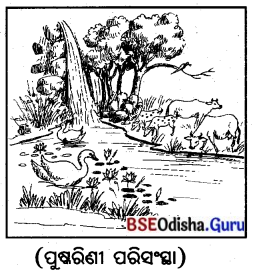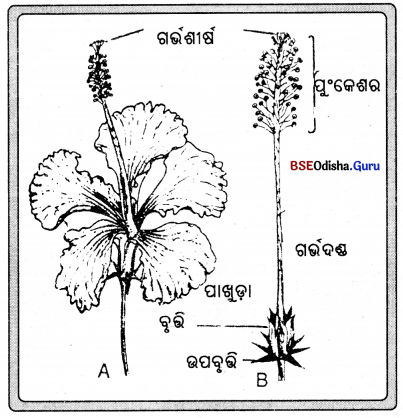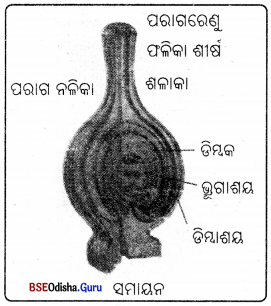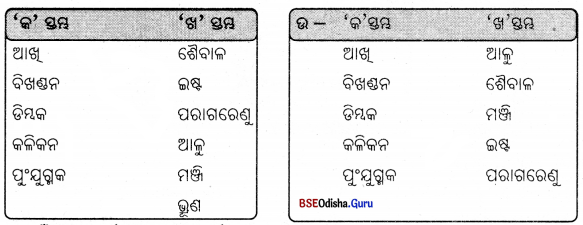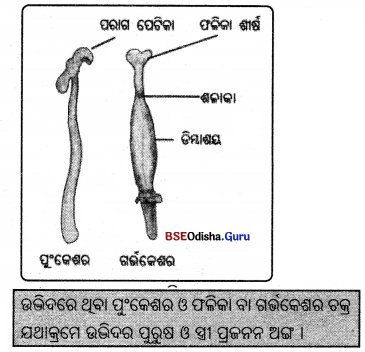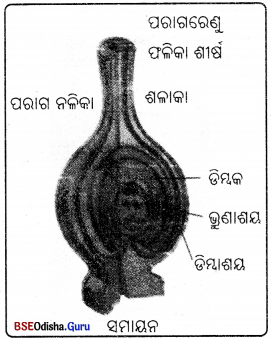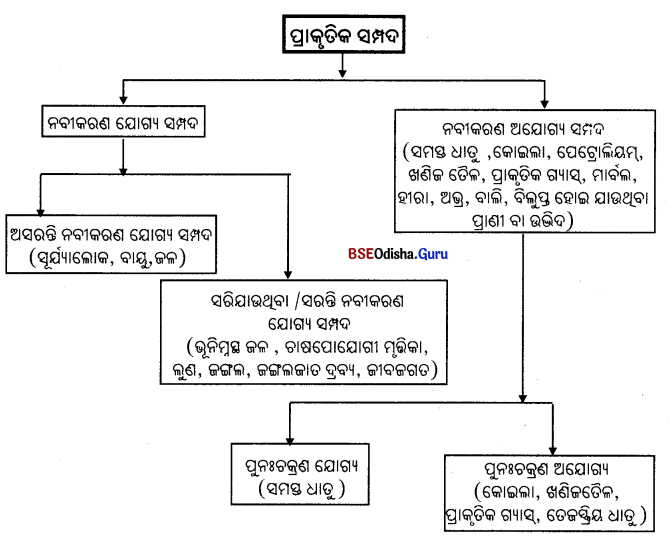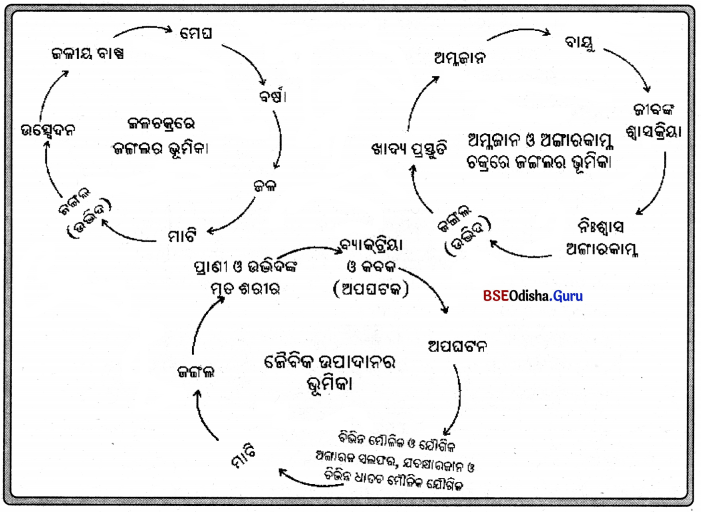Odisha State Board BSE Odisha 7th Class Geography Solutions Chapter 2 ବାୟୁମଣ୍ଡଳ Textbook Exercise Questions and Answers.
BSE Odisha Class 7 Geography Solutions Chapter 2 ବାୟୁମଣ୍ଡଳ
Question ୧।.
ବାୟୁମଣ୍ଡଳର ସ୍ତରଗୁଡ଼ିକର ନାମ ଲେଖ ଓ ସେଗୁଡ଼ିକ ସମ୍ପର୍କରେ ସଂକ୍ଷେପରେ ଆଲୋଚନା କର ।
Answer:
- ବାୟୁମଣ୍ଡଳର ତାପମାତ୍ରାକୁ ଭିଭିକରି ବାୟୁମଣ୍ଡଳକୁ ପାଞ୍ଚଗୋଟି ସ୍ତରରେ ବିଭକ୍ତ କରାଯାଇଛି; ଯଥା- ଟ୍ରପୋସ୍ଟିଅର୍, ଷ୍ଟ୍ରାଟୋସ୍ପିଅର୍, ମେସୋସ୍ପିଅର୍, ଥର୍ମୋସ୍ପିଅର୍ ଏବଂ ଏକ୍ସୋସ୍ପିଅର୍।
- ଟ୍ରପୋସ୍ପିଅର୍ : ଏହା ବାୟୁମଣ୍ଡଳର ସର୍ବନିମ୍ନ ସ୍ତର । ଏହାର ହାରାହାରି ଉଚ୍ଚତା ୧୨ କିଲୋମିଟର । ମେରୁ ଅଞ୍ଚଳରେ ଏହାର ଉଚ୍ଚତା ପ୍ରାୟ ୮ କିଲୋମିଟର ଏବଂ ବିଷୁବ ଅଞ୍ଚଳରେ ପ୍ରାୟ ୧୬ କିଲୋମିଟର । ଏହି ସ୍ତରରେ ବୃଷ୍ଟିପାତ, ତୁଷାରପାତ, କୁହୁଡ଼ି, କୁଆପଥର ଆଦି ଜଳବାୟୁ ଓ ପାଣିପାଗ ସମ୍ବନ୍ଧୀୟ ଘଟଣାବଳୀ ଘଟିଥାଏ ।
- ଷ୍ଟ୍ରାଟୋସ୍ପିଅର୍ : ଟ୍ରପୋସ୍ପିଅର୍ ଉପରକୁ ଅବସ୍ଥିତ ଏହି ସ୍ତରଟି ପ୍ରାୟ ୫୦ କିଲୋମିଟର ଉଚ୍ଚତା ପର୍ଯ୍ୟନ୍ତ ବ୍ୟାପି ରହିଛି । ଏହାର ନିମାଂଶରେ ଓଜୋନ୍ ଗ୍ୟାସ୍ ରହିଛି । ଏଠାରେ ଧୂଳିକଣା ଓ ଜଳୀୟବାଷ୍ପ ନ ଥିବାରୁ ଜଳବାୟୁ ସମ୍ବନ୍ଧୀୟ ଘଟଣା ସଂଗଠିତ ହୁଏ ନାହିଁ । ବିମାନ ଚଳାଚଳ ପାଇଁ ଏହି ସ୍ତରଟି ଅନୁକୂଳ ।
- ମେସୋସ୍ପିଅର୍ : ମେସୋସ୍ପିଅର୍ ଉପରକୁ ପ୍ରାୟ ୮୦ କି.ମି. ଉଚ୍ଚତା ବ୍ୟାପୀ ଥିବା ଏହି ସ୍ତରରେ ଉଚ୍ଚତା ବୃଦ୍ଧି ସହ ତାପମାତ୍ରା ହ୍ରାସ ପାଇଥାଏ ।
- ଥର୍ମୋସ୍ଟି ଅର୍ : ମେସୋସ୍ପିଅର୍ ଉପରକୁ ପ୍ରାୟ ୮୦ କି.ମି.ଠାରୁ ବାୟୁମଣ୍ଡଳ ଶେଷ ପର୍ଯ୍ୟନ୍ତ ଏହି ସ୍ତର ପରିବ୍ୟାପ୍ତ । ଏହି ସ୍ତରରେ ଉଚ୍ଚତା ବୃଦ୍ଧି ସହ ତାପମାତ୍ରା ଅଧୁକ ବୃଦ୍ଧି ପାଏ । ଏହାର ନିମାଂଶ ପ୍ରାୟ ୮୦ କି.ମି.ରୁ ୪୦୦ କି.ମି. ଉଚ୍ଚତା ପର୍ଯ୍ୟନ୍ତ ସ୍ତରରେ ଘନୀଭୂତ ଆୟନ କଣିକା ଥିବାରୁ ଏହାକୁ ଆୟୋନୋସ୍ପିଅର୍ କୁହାଯାଏ ।
- ଏକ୍ସୋସ୍ପିଅର୍ : ହିଲିୟମ୍ ଓ ଉଦ୍ଜାନ ଭଳି ହାଲୁକା ଗ୍ୟାସ୍ ଥିବା ଏହି ପତଳା ସ୍ତରଟି ବାୟୁମଣ୍ଡଳର ବାହ୍ୟ ସ୍ତର ।
Question ୨।.
ଜଳବାୟୁର ନିୟାମକଗୁଡ଼ିକ ଲେଖ । ଯେକୌଣସି ଦୁଇଟି ନିୟାମକ ଉପରେ ଆଲୋଚନା କର ।
Answer:
- ଜଳବାୟୁର ନିୟାମକଗୁଡ଼ିକ ହେଲା- କୌଣସି ସ୍ଥାନର ଅକ୍ଷାଂଶ, ସମୁଦ୍ର ପତ୍ତନରୁ ଉଚ୍ଚତା, ଜଳ ଓ ସ୍ଥଳଭାଗର ବଣ୍ଟନ, ସାମୁଦ୍ରିକ ସ୍ରୋତ, ପବନର ଦିଗ ଓ ଉଭିଦ ।
- ଏଥୁମଧ୍ୟରୁ ଦୁଇଟି ନିୟାମକ ସମ୍ପର୍କରେ ଆଲୋଚନା
କରାଗଲା :
(a) ଅକ୍ଷାଂଶ ; କୌଣସି ସ୍ଥାନର ଅକ୍ଷାଂଶ ଉପରେ ସେହି ସ୍ଥାନର ସୌରରଶ୍ମି ସଂଗ୍ରହର ପରିମାଣ ନିର୍ଭର କରେ । ନିମ୍ନ ଅକ୍ଷାଂଶରେ ଅର୍ଥାତ୍ ବିଷୁବ ଅଞ୍ଚଳରେ ସୂର୍ଯ୍ୟରଶ୍ମି ଲମ୍ବ ବା ସଳଖ ଭାବରେ ପଡୁଥିବାରୁ ତାପମାତ୍ରା ଅଧିକ ହୁଏ । ସେହିପରି ଅକ୍ଷାଂଶ ବୃଦ୍ଧି ସହ ସୌରତାପର ପରିମାଣ କମି କମି ଯାଏ । ଭୁଚ୍ଚ ଅକ୍ଷାଂଶରେ ସୂର୍ଯ୍ୟକିରଣ ତୀର୍ଯ୍ୟକ୍ ଭାବରେ ପଡ଼ୁଥିବାରୁ ତାପମାତ୍ରା କମ୍ ହୁଏ ।
(b) ସମୁଦ୍ର ପତ୍ତନଠାରୁ ଉଚ୍ଚତା ; ସମୁଦ୍ର ପତ୍ତନରେ ବାୟୁର ତାପମାତ୍ରା ଅଧିକ ଥାଏ । ଉଚ୍ଚତା ବୃଦ୍ଧି ହେଲେ ତାପମାତ୍ରା ହ୍ରାସ ପାଏ । ସେହିପରି ସମୁଦ୍ର ପତ୍ତନରେ ବାୟୁର ଘନତା ଅଧିକ ଥିବାରୁ ବାୟୁଚାପ ଅଧିକ । ଉଚ୍ଚତା ବୃଦ୍ଧି ସହ ବାୟୁଚାପ ହ୍ରାସ ପାଏ ।
![]()
Question ୩।.
ପୃଥିବୀର ଚାପ ବଳୟ ଚିତ୍ର ଆଙ୍କ । ବିଭିନ୍ନ ଚାପ ବଳୟ ଉପରେ ସଂକ୍ଷେପରେ ବର୍ଣ୍ଣନା କର ।
Answer:
- ପୃଥିବୀପୃଷ୍ଠରେ ୩ ଗୋଟି ଲଘୁଚାପ ବଳୟ ଓ ୪ ଗୋଟି ଗୁରୁଚାପ ବଳୟ ସ୍ଥାୟୀଭାବରେ ରହିଛି ।
- ବିଷୁବମଣ୍ଡଳ ସୂର୍ଯ୍ୟକିରଣରୁ ଅଧିକ ଉତ୍ତାପ ପାଉଥିବା ହେତୁ ଏଠାରେ ଲଘୁଚାପ ସୃଷ୍ଟି ହୁଏ, ତେଣୁ ଏଠାରେ ନିରକ୍ଷୀୟ ଲଘୁଚାପ ବଳୟ ସୃଷ୍ଟି ହୋଇଛି । ଏଠାରେ ବାୟୁ ସର୍ବଦା ତଳୁ ଉପର ଆଡ଼କୁ ଗତି କରିଥାଏ ।
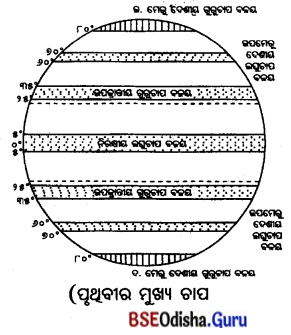
- ବିଷୁବ ଅଞ୍ଚଳରୁ ଉତ୍ତପ୍ତ ବାୟୁ ଉପରକୁ ଉଠି ଉଭୟ ମେରୁ ଆଡ଼କୁ ପ୍ରବାହିତ ହୋଇଥାଏ । ଉପର ସ୍ତରରେ ଏହି ବାୟୁ କ୍ରାନ୍ତୀୟ ଅଞ୍ଚଳରେ ପହଞ୍ଚିବାବେଳକୁ ଥଣ୍ଡା ହୋଇ ଉଭୟ ଗୋଲାର୍ଦ୍ଧର ୨୫°ରୁ ୩୫° ସମାକ୍ଷରେଖା ମଧ୍ଯରେ ନିମ୍ନଗାମୀ ହୁଏ । ତେଣୁ ଏଠାରେ ଉପକ୍ରାନ୍ତୀୟ ଗୁରୁଚାପ ବଳୟ ସୃଷ୍ଟି ହୋଇଛି ।
- ଉଭୟ ଗୋଲାର୍ଦ୍ଧର ୬୦°ରୁ ୭୦° ସମାକ୍ଷରେଖା ମଧ୍ଯରେ ସୃଷ୍ଟି ହେଉଥିବା ଚାପବଳୟକୁ ଉପମେରୁ ଲଘୁଚାପ ବଳୟ କୁହାଯାଏ । ଦୁଇ ମେରୁବୃତ୍ତ ନିକଟରେ ପୃଥିବୀର ଆବର୍ତ୍ତନ ବେଗ ଅଧିକ ଥିବା ହେତୁ ଏହି ଅଞ୍ଚଳର ବାୟୁ କ୍ରାନ୍ତୀୟ ଅଞ୍ଚଳକୁ ବିକ୍ଷିପ୍ତ ହେଉଥିବାରୁ ବାୟୁ ପତଳା ହୋଇ ଲଘୁଚାପ ବଳୟ ସୃଷ୍ଟି ହୋଇଛି ।
- ସେହିପରି ଉଭୟ ମେରୁ ଅଞ୍ଚଳର ବାୟୁ ଶୀତଳ ଓ- ଓଜନିଆ ହେତୁ ଏହି ଅଞ୍ଚଳରେ ବାୟୁର ଚାପ ଅଧିକ ହୁଏ । ତେଣୁ ଉଭୟ ମେରୁ ଅଞ୍ଚଳରେ ମେରୁମଣ୍ଡଳୀୟ ଗୁରୁଚାପ ବଳୟ ସୃଷ୍ଟି ହୋଇଛି ।
Question ୪।.
ବାୟୁପ୍ରବାହର ବିଭାଗୀକରଣ କରି ଯେକୌଣସି ଗୋଟିଏ ବିଭାଗ ଉପରେ ବର୍ଣ୍ଣନା କର ।
Answer:
ବାୟୁପ୍ରବାହକୁ ମୁଖ୍ୟତଃ ଚାରିଶ୍ରେଣୀରେ ବିଭକ୍ତ କରାଯାଏ; ଯଥା- ନିୟତ ବାୟୁ ପ୍ରବାହ, ସାମୟିକ ବାୟୁ ପ୍ରବାହ, ସ୍ଥାନୀୟ ବାୟୁପ୍ରବାହ ଓ ଆକସ୍ମିକ ବାୟୁପ୍ରବାହ । ନିୟତ ବାୟୁପ୍ରବାହ ଏକ ସ୍ଥାୟୀ ବାୟୁପ୍ରବାହ ଅଟେ ।
- ପୃଥିବୀର ସ୍ଥାୟୀ ଗୁରୁଚାପ ବଳୟରୁ ସ୍ଥାୟୀ ଲଘୁଚାପ ବଳୟକୁ ଏକ ନିର୍ଦ୍ଦିଷ୍ଟ ଦିଗରେ ବହୁଥିବା ବାୟୁକୁ ନିୟତ ବାୟୁ କୁହାଯାଏ । ଆୟନ ବାୟୁ, ପଶ୍ଚିମା ବାୟୁ ଓ ମେରୁ ବାୟୁ ଏହି ବାୟୁର ଅନ୍ତର୍ଗତ ।
- ଉପକ୍ରାନ୍ତୀୟ ‘ଗୁରୁଚାପ ବଳୟରୁ ନିରକ୍ଷୀୟ ଲଘୁଚାପ ବଳୟକୁ ପ୍ରବାହିତ ବାୟୁକୁ ଆୟନ ବାୟୁ କୁହାଯାଏ ।
- ଉତ୍ତର ଗୋଲାର୍ଦ୍ଧରେ ଏହା ଉତ୍ତର-ପୂର୍ବ ଏବଂ ଦକ୍ଷିଣ ଗୋଲାର୍ଦ୍ଧରେ ଦକ୍ଷିଣ-ପୂର୍ବ ଦିଗରୁ ପ୍ରବାହିତ ହେଉଥିବାରୁ ଏହାର ନାମ ଯଥାକ୍ରମେ ଉତ୍ତର-ପୂର୍ବ ଆୟନ ବାୟୁ ଓ ଦକ୍ଷିଣ-ପୂର୍ବ ଆୟନ ବାୟୁ ଅଟେ ।
- ଉପକ୍ରାନ୍ତୀୟ ଗୁରୁଚାପ ବଳୟରୁ ଉପମେରୁ ଲଘୁଚାପ ବଳୟକୁ ପ୍ରବାହିତ ହେଉଥିବା ବାୟୁକୁ ପଶ୍ଚିମାବାୟୁ କୁହାଯାଏ । ଏହି ବାୟୁ ଉତ୍ତର ଗୋଲାର୍ଦ୍ଧରେ ଦକ୍ଷିଣ- ପଶ୍ଚିମ କୋଣରୁ ଏବଂ ଦକ୍ଷିଣ ଗୋଲାର୍ଦ୍ଧରେ ଉତ୍ତର – ପଶ୍ଚିମ କୋଣରୁ ବହେ । ଏହାର ଦିଗ ଓ ବେଗ ପରିବର୍ତ୍ତନଶୀଳ ଥିବାରୁ ଏହାକୁ ପରିବର୍ତ୍ତନଶୀଳ ପଶ୍ଚିମାବାୟୁ କୁହାଯାଏ ।
- ଉଭୟ ଗୋଲାର୍ଦ୍ଧରେ ମେରୁମଣ୍ଡଳୀୟ ଗୁରୁଚାପ ଅଞ୍ଚଳରୁ ଉପମେରୁ ଲଘୁଚାପ ବଳୟକୁ ପ୍ରବାହିତ ମେରୁବାୟୁ ଉତ୍ତର ଗୋଲାର୍ଦ୍ଧରେ ଉତ୍ତର-ପୂର୍ବ ଦିଗରୁ ଏବଂ ଦକ୍ଷିଣ ଗୋଲାର୍ଦ୍ଧରେ ଦକ୍ଷିଣ-ପୂର୍ବ ଦିଗରୁ ପ୍ରବାହିତ ହୁଏ ।
![]()
Question ୫।.
ବୃଷ୍ଟିପାତ କ’ଣ ? ବିଭିନ୍ନ ପ୍ରକାର ବୃଷ୍ଟିପାତ ସମ୍ବନ୍ଧରେ ଆଲୋଚନା କର ।
Answer:
ମେଘରେ ଥିବା ଜଳକଣା ଘନୀଭୂତ ହୋଇ ଜଳ ଆକାରରେ ଭୂପୃଷ୍ଠରେ ପଡ଼ିବାକୁ ବୃଷ୍ଟିପାତ କୁହାଯାଏ ।
ବୃଷ୍ଟିପାତ ତିନି ପ୍ରକାରର, ଯଥା- ପରିଚଳନ ବୃଷ୍ଟିପାତ, ଶୈଳୋତ୍ରକ୍ଷେପ ବୃଷ୍ଟିପାତ ଏବଂ ବାତାବର୍ଷ ବୃଷ୍ଟିପାତ ।
ପରିଚଳନ ବୃଷ୍ଟିପାତ : ସୂର୍ଯ୍ୟରଶ୍ମି ଦ୍ଵାରା ଭୂପୃଷ୍ଠ ଉତ୍ତପ୍ତ ହେଲେ ଭୂପୃଷ୍ଠ ସହ ଲାଗିରହିଥିବା ବାୟୁ ଉତ୍ତପ୍ତ ହୋଇ ଉପରକୁ ଉଠେ ଏବଂ ପରିଚଳନ ବାୟୁପ୍ରବାହ ସୃଷ୍ଟି ହୁଏ । ଏହି ବାୟୁରେ ଜଳୀୟବାଷ୍ପ ଥିଲେ ଏହା ଆକାଶରେ ବହୁ ଉଚ୍ଚରେ ମେଘ ସୃଷ୍ଟିକରି ସଙ୍ଗେ ସଙ୍ଗେ ପ୍ରବଳ ବର୍ଷା ‘କରାଯାଏ । ପରିଚଳନ ବାୟୁସ୍ରୋତ ଫଳରେ ଏହି ବର୍ଷା ହେଉଥିବାରୁ ଏହାକୁ ପରିଚଳନ ବୃଷ୍ଟିପାତ କୁହାଯାଏ।
ଶୈଳୋକ୍ଷେପ ବୃଷ୍ଟିପାତ : ଜଳୀୟବାଷ୍ପପୂର୍ଣ୍ଣ ବାୟୁ କୌଣସି ଉଚ୍ଚଭୂମି କିମ୍ବା ପର୍ବତରେ ବାଧାପାଇ ଉପରକୁ ଉଠେ । ଉପରକୁ ଉଠିଯିବା ଫଳରେ ତାହା ଶୀତଳ ହୋଇ ପରିପୃକ୍ତ ହୁଏ। ଏହାର କ୍ଷୁଦ୍ର ଜଳକଣାସବୁ ଜଳବିନ୍ଦୁରେ ପରିଣତ ହୋଇ ବୃଷ୍ଟି ଆକାରରେ ପଡ଼େ । ଏହାକୁ ଶୈଳୋତ୍କ୍ଷେପ ବୃଷ୍ଟିପାତ କୁହାଯାଏ । ପର୍ବତର ପ୍ରତିବାତ ପାର୍ଶ୍ଵରେ ପ୍ରବଳ ବୃଷ୍ଟିପାତ ହୁଏ, ମାତ୍ର ଅନୁବାତ ପାର୍ଶ୍ଵରେ କମ୍ ବୃଷ୍ଟିପାତ ହୋଇଥାଏ।
ବାତାବର୍ଷ ଜନିତ ବୃଷ୍ଟିପାତ ; କ୍ରାନ୍ତିମଣ୍ଡଳ ଅନ୍ତର୍ଗତ ସମୁଦ୍ର ଉପରେ ବାୟୁଚାପ ହ୍ରାସ ପାଇବା ଫଳରେ ସୃଷ୍ଟି ହୋଇଥୁବା ଲଘୁଚାପ କେନ୍ଦ୍ର ଆଡ଼କୁ ବାୟୁ ପ୍ରବାହିତ ହୁଏ । ଏହି ବାୟୁ ଘୂରି ଘୂରି ଉପରକୁ ଉଠିଯାଏ ଓ ଏଥିରେ ଥିବା ଜଳୀୟବାଷ୍ପ ଘନୀଭୂତ ହୋଇ ପ୍ରବଳ ବର୍ଷା କରାଏ।
Question ୬।
‘କ’ ସ୍ତମ୍ଭରେ ଦିଆଯାଇଥବା ପ୍ରତ୍ୟେକ ବାୟୁକୁ ‘ଖ’ ସ୍ତମ୍ଭର ସମ୍ପର୍କିତ ସ୍ଥାନ ସହ ଯୋଡ଼ି ଲେଖ।
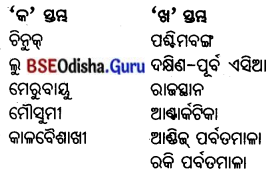
Answer:
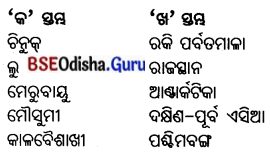
Question ୭।.
ସଂକ୍ଷିପ୍ତ ଟିପ୍ପଣୀ ଲେଖ ।
ଆୟନୋସ୍ଟି ଅର୍, ବାଣିଜ୍ୟବାୟୁ, ପ୍ରତୀପ ବାତାବର୍ଷ, ସୌରାଭିତାପ, କୁହୁଡ଼ି
Answer:
ଆୟନୋକ୍ସି ଅର୍ :
- ଥର୍ମୋସ୍ଟି ଅର୍ର ନିମାଂଶକୁ ଆୟନୋସ୍ଟିଅର୍ କୁହାଯାଏ, କାରଣ ଏହି ସ୍ତରରେ ଆୟନ କଣିକାଗୁଡ଼ିକ ଘନୀଭୂତ ହୋଇ ରହିଥାନ୍ତି । ଏହା ପ୍ରାୟ ୮୦ କି.ମି.ରୁ ୪୦୦ କି.ମି. ଉଚ୍ଚତା ପର୍ଯ୍ୟନ୍ତ ବିସ୍ତୃତ ।
- ଏହି ସ୍ତର ଯୋଗୁ ଦୂର ସ୍ଥାନକୁ ବେତାର ତରଙ୍ଗ ପ୍ରସାରଣ ସମ୍ଭବ ହୋଇଥାଏ ।
ବାଣିଜ୍ୟ ବାୟୁ :
- ଆୟନ ବାୟୁକୁ ବାଣିଜ୍ୟ ବାୟୁ କୁହାଯାଏ । କାରଣ ପୂର୍ବେ ପାଲଟଣା ବୋଇତରେ ବାଣିଜ୍ୟ କାରବାରରେ ଏହା ସହାୟକ ହେଉଥିବାରୁ ଏହାର ନାମକରଣ ବାଣିଜ୍ୟ ବାୟୁ ହୋଇଅଛି ।
- ଏହି ବାୟୁ ଉତ୍ତର ଗୋଲାର୍ଦ୍ଧରେ ଉତ୍ତର-ପୂର୍ବ ଦିଗରୁ ଏବଂ ଦକ୍ଷିଣ ଗୋଲାର୍ଦ୍ଧରେ ଦକ୍ଷିଣ-ପୂର୍ବ ଦିଗରୁ ପ୍ରବାହିତ ହୁଏ ।
![]()
ପ୍ରତୀପ ବାତାବର୍ଷ :
- କୌଣସି ସ୍ଥାନରେ ବାୟୁଚାପ ହଠାତ୍ ବୃଦ୍ଧି ପାଇ ଗୁରୁଚାପ କେନ୍ଦ୍ର ସୃଷ୍ଟି ହୁଏ। ଏହି ଗୁରୁଚାପ କେନ୍ଦ୍ରରୁ ବାୟୁ ଧୀରେ ଧୀରେ ଚାରିପାଖରେ ଥିବା ଅଳ୍ପ ଚାପ ଅଞ୍ଚଳ ଆଡ଼କୁ ପ୍ରବାହିତ ହୁଏ।
- ଉତ୍ତର ଗୋଲାର୍ଦ୍ଧରେ ଏହି ବାୟୁ ଡାହାଣକୁ ବାଙ୍କିଯାଇ ଘଣ୍ଟାକଣ୍ଟାର ଘୂର୍ଶନ ଦିଗରେ (ଦକ୍ଷିଣାବର୍ଷ) ଓ ଦକ୍ଷିଣ ଗୋଲାର୍ଦ୍ଧରେ ବାମକୁ ବାଙ୍କିଯାଇ ଘଣ୍ଟାକଣ୍ଟାର ବିପରୀତ ଦିଗରେ (ବାମାବର୍ତ୍ତ) ପ୍ରବାହିତ ହୁଏ।
- ପ୍ରତୀପ ବାତାବର୍ଷ ଯୋଗୁ ପାଗ ଶୁଖୁଲା ରହେ ଓ ଆକାଶ ମେଘମୁକ୍ତ ଥାଏ।
ସୌରାଭିତାପ :
- ଭୂପୃଷ୍ଠରେ ସଂଗୃହୀତ ସୌରରଶ୍ମିର ପରିମାଣକୁ ସୌରାଭିତାପ କୁହାଯାଏ।
- ସୌରାଭିତାପର ପରିମାଣ ବିଷୁବରେଖାଠାରୁ ମେରୁ ଆଡ଼କୁ କ୍ରମଶଃ ହ୍ରାସ ପାଇଥାଏ । ମାତ୍ର ଋତୁଭେଦରେ ଏହି ପରିମାଣରେ ବ୍ୟତିକ୍ରମ ଦେଖାଯାଏ।
କୁହୁଡ଼ି :
- ଶୀତକାଳରେ ବାୟୁର ତାପମାତ୍ରା ଶିଶିରାଙ୍କ ତଳକୁ ଖସିଆସିଲେ ଏଥିରେ ଥିବା ଜଳୀୟବାଷ୍ପ ଘନୀଭୂତ ହୁଏ। ବାୟୁରେ ଭାସମାନ ଅବସ୍ଥାରେ ଥିବା ଧୂଳିକଣାକୁ ଆଶ୍ରୟ କରି ଏଗୁଡ଼ିକ ଭୂପୃଷ୍ଠର ଅଳ୍ପ ଉଚ୍ଚତାରେ ଭାସିବୁଲେ। ଏହାକୁ କୁହୁଡ଼ି କୁହାଯାଏ।
- କୁହୁଡ଼ିର ସୃଷ୍ଟିକୁ ଭିଭିକରି ଏହାକୁ ଦୁଇ ଭାଗରେ ବିଭକ୍ତ କରାଯାଏ; ଯଥା- ବିକିରଣ କୁହୁଡ଼ି ଓ ଅଭିବହନ କୁହୁଡ଼ି। ଭୂପୃଷ୍ଠର ତାପ ବିକିରଣରୁ ସୃଷ୍ଟି ହେଉଥିବା କୁହୁଡ଼ିକୁ ବିକିରଣ କୁହୁଡ଼ି ଏବଂ ଶୀତଳ ବାୟୁ ଓ ଉଷ୍ଣ ଆର୍ଦ୍ର ବାୟୁର ମିଶ୍ରଣରେ ସୃଷ୍ଟି ହେଉଥିବା କୁହୁଡ଼ିକୁ ଅଭିବହନ କୁହୁଡ଼ି କୁହାଯାଏ । କୁହୁଡ଼ି ଅତି ପତଳା ହେଲେ ଏହାକୁ ମିଷ୍ଟ୍ କୁହାଯାଏ।
୮। ଭୌଗୋଳିକ କାରଣ ଲେଖ।
Question କ.
ଷ୍ଟ୍ରାଟୋସ୍ପିଅର୍ ବିମାନ ଚଳାଚଳ ପାଇଁ ଅନୁକୂଳ ।
Answer:
- ଷ୍ଟ୍ରାଟୋସ୍ଟି ଅର୍ ସ୍ତରରେ ଧୂଳିକଣା ଓ ଜଳୀୟବାଷ୍ପ ନ ଥାଏ । ତେଣୁ ମେଘ ବା ଜଳବାୟୁ ସମ୍ବନ୍ଧୀୟ ଘଟଣା ଏଠାରେ ସଂଗଠିତ ହୁଏ ନାହିଁ ।
- ସେଥିପାଇଁ ବିମାନ ଚଳାଚଳ ପାଇଁ ଏହା ଏକ ଅନୁକୂଳ ସ୍ତର ।
Question ଖ.
ଶୀତରାତିରେ କୁହୁଡ଼ି ସୃଷ୍ଟି ହୁଏ ।
Answer:
- କୁହୁଡ଼ି ସୃଷ୍ଟି ପାଇଁ ଲମ୍ବା ଶୀତରାତି, ନିର୍ମଳ ଆକାଶ ଓ ଧୀର ବାୟୁପ୍ରବାହ ଆବଶ୍ୟକ । ତେଣୁ ଶୀତରାତିରେ ଦିନ ଭାଗ ଛୋଟ ଓ ରାତ୍ରି ଭାଗ ଅଧିକ ଥାଏ । ଶୀତଋତୁରେ ଆକାଶ ପ୍ରାୟତଃ ନିର୍ମଳ ଥାଏ, ଫଳରେ ପୃଥିବୀପୃଷ୍ଠ ଶୀଘ୍ର ତାପ ବିକିରଣ କରି ଥଣ୍ଡା ହୁଏ ।
- ସେତେବେଳେ ଶୀତଳ ଭୂପୃଷ୍ଠକୁ ଲାଗିଥିବା ବାୟୁ ଥଣ୍ଡା ହୁଏ ଓ ଶିଶିରାଙ୍କ ତଳକୁ ତାପମାତ୍ରା ଖସିଲେ ଏଥିରେ ଥିବା ଜଳୀୟବାଷ୍ପ ଘନୀଭୂତ ହୁଏ । ଏହା ବାୟୁରେ ଥିବା ଭାସମାନ ଧୂଳିକଣାକୁ ଆଶ୍ରୟ କରି କୁହୁଡ଼ି ରୂପରେ ପରିବର୍ଜିତ ହୁଏ ।
Question ଗ.
ପଶ୍ଚିମଘାଟ ପର୍ବତମାଳାର ପୂର୍ବ ପାର୍ଶ୍ଵରେ କମ୍ ବୃଷ୍ଟି ହୁଏ ।
Answer:
- ପଶ୍ଚିମଘାଟ ପର୍ବତମାଳା ଉତ୍ତର-ଦକ୍ଷିଣ ହୋଇ ଭାରତର ପଶ୍ଚିମ ଉପକୂଳରେ ବିସ୍ତୃତ । ସମୁଦ୍ରରୁ ପ୍ରବାହିତ ଜଳୀୟବାଷ୍ପପୂର୍ବ ଦକ୍ଷିଣ-ପଶ୍ଚିମ ମୌସୁମୀ ବାୟୁ ଏହାର ପଶ୍ଚିମ ପାର୍ଶ୍ଵରେ ବାଧା ପାଇ ବୃଷ୍ଟିପାତ କରାଏ ।
- ଏହା ଉପରକୁ ଉଠି ଏହି ପର୍ବତମାଳାର ପ୍ରତିବାତ ପାର୍ଶ୍ୱ ଅର୍ଥାତ୍ ପୂର୍ବ ପାର୍ଶ୍ବକୁ ନିମ୍ନଗାମୀ ହେବାଫଳରେ ଅଳ୍ପ ବୃଷ୍ଟି କରାଏ । ତେଣୁ ପଶ୍ଚିମଘାଟ ପର୍ବତମାଳାର ପୂର୍ବ ପାର୍ଶ୍ଵରେ କମ୍ ବୃଷ୍ଟି ହୁଏ ।
![]()
Question ଘ.
ନିରକ୍ଷ ଲଘୁଚାପ ବଳୟକୁ ନିରକ୍ଷ ଶାନ୍ତ ବଳୟ କୁହାଯାଏ ।
Answer:
- ନିରକ୍ଷ ଲଘୁଚାପ ବଳୟରେ ବର୍ଷସାରା ସଳଖ ସୂର୍ଯ୍ୟକିରଣ ପଡ଼ୁଥିବାରୁ ତାପମାତ୍ରା ଅଧିକ ରହେ ଓ ବାୟୁଚାପ ହ୍ରାସ ପାଏ ।
- ତେଣୁ ଏଠାରେ ବାୟୁମଣ୍ଡଳ ଶାନ୍ତ ଓ ଚଳନଶୂନ୍ୟ ଥିବାରୁ ଏହାକୁ ନିରକ୍ଷ ଶାନ୍ତ ବଳୟ କୁହାଯାଏ ।
Question ଙ.
ପୁରୀ ସହରରେ ବେଶୀ ଗରମ ବା ଥଣ୍ଡା ଅନୁଭୂତ ହୁଏ ନାହିଁ ।
Answer:
- ଜଳ ଓ ସ୍ଥଳଭାଗର ବଣ୍ଟନ କୌଣସି ଅଞ୍ଚଳର ଜଳବାୟୁକୁ ପ୍ରଭାବିତ କରିଥାଏ ।
- ସମୁଦ୍ର ଧୀରେ ଧୀରେ ଉତ୍ତପ୍ତ ଓ ବିଳମ୍ବରେ ଥଣ୍ଡା ହୁଏ । ପୁରୀ ସମୁଦ୍ରକୂଳବର୍ତ୍ତୀ ସହର ହୋଇଥିବାରୁ ଏଠାରେ ସାମୁଦ୍ରିକ ପ୍ରଭାବ ଅନୁଭୂତ ହୁଏ । ତେଣୁ ପୁରୀରେ ଖରାଦିନେ ବେଶୀ ଗରମ ବା ଶୀତଦିନେ ବେଶି ଥଣ୍ଡା ଅନୁଭୂତ ହୁଏ ନାହିଁ ।
୯ । ଶୂନ୍ୟସ୍ଥାନ ପୂରଣ କର ।
(କ) ହାଲୁକା ଗ୍ୟାସ୍ମାନ _______ ସ୍ତରରେ ମହଜୁଦ ରହିଛି ।
Answer:
ଏକ୍ସୋସ୍ପିଅର
(ଖ) ସୌରାଭିତାପର ପରିମାଣ ପୃଥିବୀର ______ ଅଞ୍ଚଳରେ ସର୍ବାଧିକ ।
Answer:
ବିଷୁବ
(ଗ) ଗତିଶୀଳ ବାୟୁକୁ ________ କୁହାଯାଏ ।
Answer:
ପବନ
(ଘ) ‘ଗର୍ଜନଶୀଳ ଚାଳିଶା’ _____ ଗୋଲାର୍ଦ୍ଧରେ ଉପଲବ୍ଧ ।
Answer:
ଦକ୍ଷିଣ
(ଙ) ବୃକ୍ଷଲତାଦି _________ ପ୍ରକ୍ରିୟାରେ ବାୟୁମଣ୍ଡଳକୁ ବାଷ୍ପ ଛାଡ଼ିଥାନ୍ତି ।
Answer:
ବାଷ୍ପମୋଚନ
![]()
(ଚ) ତାପମାତ୍ରାର ଦୈନିକ ହ୍ରାସବୃଦ୍ଧିକୁ _______ କୁହାଯାଏ ।
Answer:
ଦୈନିକ ତାପମାତ୍ରା
୧୦। ପ୍ରତ୍ୟେକକୁ ଗୋଟିଏ ଲେଖାଏଁ ଶବ୍ଦରେ ପ୍ରକାଶ କର ।
(କ) ଅତି ଉଚ୍ଚ ପର୍ବତଶ୍ରେଣୀରେ ହେଉଥିବା ବୃଷ୍ଟିପାତ ।
Answer:
ଶୈଳୋତ୍କ୍ଷେପ ବୃଷ୍ଟିପାତ
(ଖ) ବିଷୁବ ଅଞ୍ଚଳରେ ପ୍ରତ୍ୟହ ଅପରାହ୍ନରେ ହେଉଥିବା ବୃଷ୍ଟିପାତ ।
Answer:
ପରିଚଳନ ବୃଷ୍ଟିପାତ
(ଗ) ଘନୀଭବନର ବିପରୀତ କ୍ରିୟା ।
Answer:
ବାଷ୍ପୀଭବନ
(ଘ) ଦକ୍ଷିଣ-ପୂର୍ବ ଏସିଆରେ ପ୍ରବାହିତ ସାମୟିକ ବାୟୁ ।
Answer:
ମୌସୁମୀବାୟୁ
(ଙ) ସୌରଶକ୍ତି ସଂଗ୍ରହଣ ଓ ବିତରଣ ।
Answer:
ତାପବଜେଟ୍
BSE Odisha 7th Class Geography Notes Chapter 2 ବାୟୁମଣ୍ଡଳ
ବାୟୁମଣ୍ଡଳର ଗଠନ :
ବାୟୁମଣ୍ଡଳ କେତେକ ଗ୍ୟାସୀୟ ପଦାର୍ଥର ମିଶ୍ରଣ । ବାୟୁମଣ୍ଡଳରେ ଥିବା ବିଭିନ୍ନ ଗ୍ୟାସୀୟ ଉପାଦାନର ଶତକଡ଼ା ଅନୁପାତ ଓ ଏହାର ଉପଯୋଗିତା ନିମ୍ନ ସାରଣୀରୁ ଜାଣିବା :
ବାୟୁମଣ୍ଡଳର ଗ୍ୟାସୀୟ ଉପାଦାନ
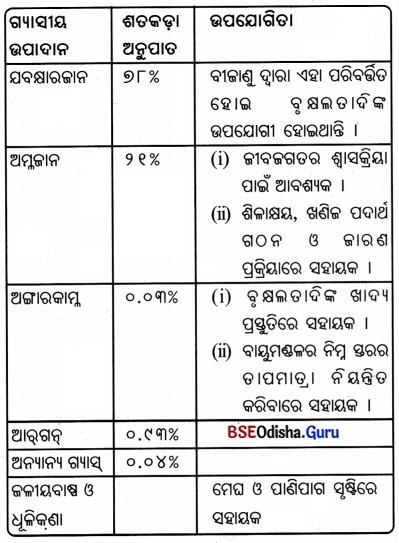
ବାୟୁମଣ୍ଡଳକୁ ନିର୍ଗତ ହେଉଥିବା ଅଙ୍ଗାରକାମ୍ଳ ଗ୍ୟାସ୍ ଭୂପୃଷ୍ଠରୁ ବିକିରିତ ତାପ ଧାରଣ କରୁଥିବାରୁ ଏହାକୁ ସବୁକ ଗୃହ ଗ୍ୟାସ୍ କୁହାଯାଏ । କଳକାରଖାନା, ଯାନବାହନରୁ ନିର୍ଗତ ଧୂଆଁରେ ଅଙ୍ଗାରକାମ୍ଳ ଗ୍ୟାସ୍ ଥିବାରୁ ଏହା ବାୟୁମଣ୍ଡଳକୁ ନିର୍ଗତ ହେଲେ ବାୟୁର ତାପମାତ୍ରା ବୃଦ୍ଧି ଘଟେ, ଯାହାକୁ ‘ବିଶ୍ଵତାପନ’ ବା ‘Global warming” କୁହାଯାଏ ।
ବାୟୁମଣ୍ଡଳର ବିଭିନ୍ନ ସ୍ତର :
ସମୁଦ୍ରପୃଷ୍ଠରୁ ୧୬୦୦ କି.ମି. ଉଚ୍ଚତା ବ୍ୟାପୀ ବାୟୁମଣ୍ଡଳକୁ ୫ ଗୋଟି ସ୍ତରରେ ବିଭକ୍ତ କରାଯାଇଛି ।
ବାୟୁମଣ୍ଡଳର ସ୍ତର :
(i) ଟ୍ରପୋସ୍ପିଅର :
- ଏହା ବାୟୁମଣ୍ଡଳର ସର୍ବନିମ୍ନ ସ୍ତର ତଥା ଜୀବଜଗତ ପାଇଁ ଗୁରୁତ୍ଵପୂର୍ଣ୍ଣ ସ୍ତର ।
- ଏହାର ହାରାହାରି ଉଚ୍ଚତା ୧୨ କି.ମି. ।
- ଏହି ସ୍ତରରେ ପାଣି ପାଗ ତଥା ଜଳବାୟୁର ପରିବର୍ତ୍ତନ ଘଟିଥାଏ ।
[ଟ୍ରପୋସ୍ପିଅର ଓ ଷ୍ଟ୍ରାଟୋସ୍ପିଅର ମଝିରେ ଟ୍ରପୋପଜ ନାମକ ପତଳା ସ୍ତର ଅଛି ।]
![]()
(ii) ଷ୍ଟ୍ରାଟୋସ୍ପିଅର :
- ଟ୍ରପୋସ୍ପିଅରଠାରୁ ୫୦ କି.ମି. ଉଚ୍ଚତା ବିଶିଷ୍ଟ ଏହି ସ୍ତର ବିମାନ ଚଳାଚଳ ପାଇଁ ଅନୁକୂଳ ।
- ଏହା ଧୂଳିକଣା ଓ ଜଳୀୟ ବାଷ୍ପଶୂନ୍ୟ ।
- ଏହାର ନିମାଂଶରେ ଓଜୋନ ସ୍ତର ରହିଛି ।
[ଷ୍ଟ୍ରାଟୋସ୍ପିଅର ଓ ମେସୋସ୍ପିଅର ମଝିରେ ଷ୍ଟ୍ରାଟୋପଜ୍ ନାମକ ଏକ ସ୍ତର ରହିଛି ।]
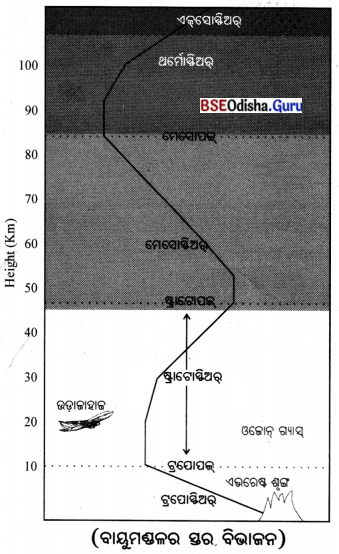
(iii) ମେସୋସ୍ପିଅର :
- ଷ୍ଟ୍ରାଟୋସ୍ପିଅର ଉପରକୁ ଏହି ସ୍ତର ପ୍ରାୟ ୮୦ କି.ମି. ଉଚ୍ଚତା ପର୍ଯ୍ୟନ୍ତ ବ୍ୟାପ୍ତ ।
- ଏହି ସ୍ତରରେ ଉଚ୍ଚତା ବୃଦ୍ଧି ସହ ତାପମାତ୍ରା ହ୍ରାସ ପାଏ ।
[ମେସୋସ୍ଫି ଅଶ ଓ ଥର୍ମୋସ୍ପିଅର ମଝିରେ ମେସୋପଜ ନାମକ ଏକ ପତଳା ବଳୟ ରହିଛି ।]
(iv) ଥର୍ମୋସ୍ଟିଅର :
- ୮୦ କି.ମି.ରୁ ବାୟୁମଣ୍ଡଳ ଶେଷପର୍ଯ୍ୟନ୍ତ ବ୍ୟାପ୍ତ ଏହି ସ୍ତରରେ ଉଚ୍ଚତା ବୃଦ୍ଧି ସଙ୍ଗେ ତାପମାତ୍ରା ବୃଦ୍ଧି ଘଟେ ।
(v) ଏକ୍ସ୍ଟିଅର :
- ବାୟୁମଣ୍ଡଳର ଏହି ବାହ୍ୟ ସ୍ତରରେ ବାୟୁ ଅତି ପତଳା ଓ ହିଲିୟମ୍ ଓ ଉଦ୍ଜାନ ଗ୍ୟାସ୍ରେ ଏହି ସ୍ତରଟି ସମୃଦ୍ଧ ।
ପାଣିପାଗ ଓ ଜଳବାୟୁ :
- ପାଗ ପରିବର୍ତ୍ତନଶୀଳ । ଏହା ସ୍ଥାନରୁ ସ୍ଥାନକୁ ଓ ସମୟରୁ ସମୟକୁ ବଦଳିଥାଏ ।
- ଜଳବାୟୁ ପାଗ ଭଳି ପରିବର୍ତ୍ତନଶୀଳ ନୁହେଁ । ଭାରତୀୟ ଉପମହାଦେଶର ଜଳବାୟୁ କ୍ରାନ୍ତୀୟ ଜଳବାୟୁ ।
- କେଉଁ ଦେଶରେ କେଉଁ ‘ଜଳବାୟୁ ଜାଣିବା :
ମାଲୟେସିଆ : ନିରକ୍ଷ ଜଳବାୟୁ
ଇଣ୍ଡୋନେସିଆ : ନିରକ୍ଷ ଜଳବାୟୁ
- କୌଣସି ସ୍ଥାନର ପାଣିପାଗର ବହୁବର୍ଷ ଧରି ହାରାହାରି ଅବସ୍ଥାକୁ ଜଳବାୟୁ କୁହାଯାଏ ।
![]()
ପାଣିପାଗ ଓ ଜଳବାୟୁର ନିୟାମକ :
କେତେକ ନିୟାମକ ଦ୍ଵାରା ପାଣିପାଗ ଓ ଜଳବାୟୁ ନିୟନ୍ତ୍ରିତ ହୋଇଥାଏ ।
- ଅକ୍ଷାଂଶ : ନିମ୍ନ ଅକ୍ଷାଂଶରେ ସୌରରଶ୍ମି ସଳଖ ପଡ଼ୁଥିବାରୁ ଅଧିକ ଗରମ ହୁଏ । ଅକ୍ଷାଂଶ ବୃଦ୍ଧି ହେଲେ ତାପମାତ୍ରା ହ୍ରାସ ପାଏ ।
- ସମୁଦ୍ର ପତ୍ତନଠାରୁ ଉଚ୍ଚତା : ସମୁଦ୍ର ପତ୍ତନଠାରୁ ୧ କି.ମି. ଉଚ୍ଚତା ବୃଦ୍ଧିରେ ତାପମାତ୍ରା ୬.୪° ସେଲ୍ସିୟସ୍ ହାରରେ ହ୍ରାସ ପାଏ । ତେଣୁ ଉଚ୍ଚତା ବୃଦ୍ଧି ସହ ତାପମାତ୍ରା ହ୍ରାସ ପାଏ ।
- ଜଳ ଓ ସ୍ଥଳଭାଗର ବଣ୍ଟନ : ସମୁଦ୍ରର ପ୍ରଭାବ ଯୋଗୁଁ ଉପକୂଳ ଅଞ୍ଚଳରେ ଅଧିକ ଗରମ ବା ଶୀତ ଅନୁଭୂତ ହୁଏ ନାହିଁ । କାରଣ ସ୍ଥଳଭାଗ ଶୀଘ୍ର ଉତ୍ତପ୍ତ ଓ ଶୀଘ୍ର ଥଣ୍ଡା ହୁଏ, ମାତ୍ର ଜଳଭାଗ ଧୀରେ ଧୀରେ ଉତ୍ତପ୍ତ ହୁଏ ଓ ବିଳମ୍ବରେ ଥଣ୍ଡା ହୁଏ ।
- ସାମୁଦ୍ରିକ ସ୍ରୋତ : ଉଷ୍ଣ ସାମୁଦ୍ରିକ ସ୍ରୋତ ପ୍ରଭାବରେ ଉପକୂଳ ଅଞ୍ଚଳ ଜଳବାୟୁ ଅପେକ୍ଷାକୃତ ଉଷ୍ଣ ଓ ଶୀତଳ ସାମୁଦ୍ରିକ ସ୍ରୋତ ପ୍ରଭାବିତ ଅଞ୍ଚଳ ଅପେକ୍ଷାକୃତ ଶୀତଳ ଥାଏ ।
- ପବନର ଦିଗ ; ସମୁଦ୍ରରୁ ପ୍ରବାହିତ ବାୟୁ ଜଳୀୟବାଷ୍ପ ଗ୍ରହଣ କରିଥିବାରୁ ଏହା ବର୍ଷା କରାଏ, ମାତ୍ର ସ୍ଥଳଭାଗରୁ ପ୍ରବାହିତ ବାୟୁ ଶୁଷ୍କ ଥିବାରୁ ଏହା ବୃଷ୍ଟି କରାଇପାରେ ନାହିଁ ।
- ଉଦ୍ଭଦ : ଉଭିଦ ବହୁଳ ଅଞ୍ଚଳ (ଜଙ୍ଗଲ)ରେ ଭୂମି ଆର୍ଦ୍ର ଥାଏ ଏବଂ ବୃଷ୍ଟିପାତ ହୁଏ । ଉଭିଦ ବିହୀନ ମରୁ ଅଞ୍ଚଳ ଭୂମି ଶୁଷ୍କ ଥାଏ ଓ କମ୍ ବୃଷ୍ଟିପାତ ହୁଏ ।
ଜଳବାୟୁର ଉପାଦାନ :
ଜଳବାୟୁ କେତେକ କାରକ ବା ଉପାଦାନ ଦ୍ଵାରା ପ୍ରଭାବିତ ହୁଅନ୍ତି ।
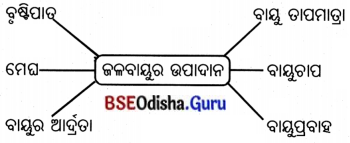
ଭୂପୃଷ୍ଠରେ ସଂଗୃହୀତ ସୌରାଭିତାପ ବିଷୁବରେଖାଠାରୁ ମେରୁ ଆଡ଼କୁ ହ୍ରାସ ପାଇଥାଏ ।
ଭୂପୃଷ୍ଠରେ ସଂଗୃହୀତ ତାପ ବାୟୁମଣ୍ଡଳକୁ ବିକିରିତ ହୋଇଥାଏ ଓ ଏହା ଅଙ୍ଗାରକାମ୍ଳ, ଜଳୀୟବାଷ୍ପ ଦ୍ବାରା ଶୋଷିତ ହୋଇ ବାୟୁମଣ୍ଡଳର ତାପମାତ୍ରାକୁ ବଢ଼ାଇ ଦିଅନ୍ତି ।
ପୃଥିବୀ ସୂର୍ଯ୍ୟଙ୍କଠାରୁ ତାପ ଶକ୍ତି ସଂଗ୍ରହ କରିବା ଓ ବାୟୁମଣ୍ଡଳକୁ ବିକିରଣ କରିବା ମଧ୍ୟରେ ସମତା ରକ୍ଷା ହେବାଦ୍ଵାରା ପୃଥିବୀର ହାରାହାରି ତାପମାତ୍ରା ସମାନ
ରହେ ।
ବାୟୁ ତାପମାତ୍ରା ଦିନବେଳା କ୍ରମଶଃ ବୃଦ୍ଧି ପାଇ ଅପରାହ୍ନରେ ସର୍ବାଧିକ ଓ ରାତିରେ କ୍ରମଶଃ ହ୍ରାସପାଇ ଭୋର୍ ସମୟରେ ସର୍ବନିମ୍ନରେ ପହଞ୍ଚିଥାଏ । ଦୈନିକ ସର୍ବୋଚ୍ଚ ଓ ସର୍ବନିମ୍ନ ତାପମାତ୍ରା ବ୍ୟବଧାନକୁ ‘ଦୈନିକ ତାପ ବ୍ୟବଧାନ’ କୁହାଯାଏ । ସେହିପରି ବର୍ଷ ମଧ୍ୟରେ ତାପମାତ୍ରାର କ୍ରମଶଃ ହ୍ରାସବୃଦ୍ଧିକୁ ‘ବାର୍ଷିକ ତାପଚକ୍ର’ କୁହାଯାଏ ।
ପୃଥିବୀର ଶକ୍ତି ସଂଗ୍ରହ ଓ ଶକ୍ତି ବିକିରଣ ମଧ୍ୟରେ ସମତା ରହିବାକୁ ପୃଥିବୀର ତାପ ବଜେଟ୍ କୁହାଯାଏ । ବର୍ଷର ଉଷ୍ଣତମ ଓ ଶୀତଳତମ ମାସ ଦ୍ବୟର ହାରାହାରି ତାପମାତ୍ରା ବ୍ୟବଧାନକୁ ବାର୍ଷିକ ତାପ ବ୍ୟବଧାନ କୁହାଯାଏ ।
ପୃଥିବୀର ମୁଖ୍ୟ ତାପମଣ୍ଡଳ :
ପୃଥିବୀରେ ପାଞ୍ଚୋଟି ତାପମଣ୍ଡଳ ଦେଖାଯାଏ, ଯଥା-
(i)
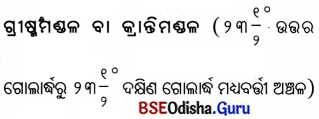
(ii) ନାତିଶୀତୋଷ୍ଣ ମଣ୍ଡଳ
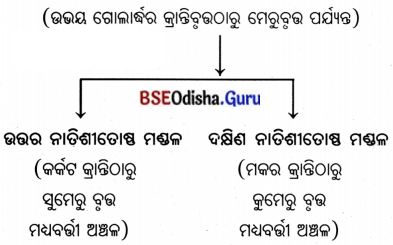
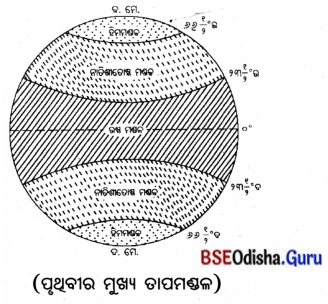
(iii) ହିମମଣ୍ଡଳ
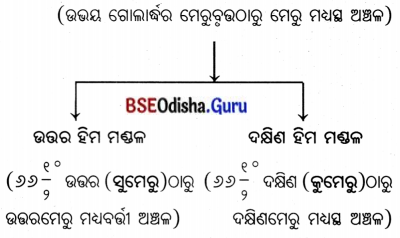
ବାୟୁମଣ୍ଡଳର ଚାପ :
- ବାୟୁର ଓଜନ ଅଛି, ତେଣୁ ବାୟୁମଣ୍ଡଳ ଭୂପୃଷ୍ଠରେ ଚାପ ପକାଏ ।
- ସମୁଦ୍ର ପତ୍ତନରେ ବାୟୁଚାପ ସର୍ବାଧିକ ଓ ଉଚ୍ଚତା ବୃଦ୍ଧିରେ ବାୟୁର ଘନତା ହ୍ରାସ ପାଉଥିବାରୁ ବାୟୁଚାପ ହ୍ରାସ ପାଏ ।
- ବ୍ୟାରୋମିଟର ବା ଚାପମାନ ଯନ୍ତ୍ରରେ ବାୟୁଚାପ ନିର୍ଣ୍ଣୟ କରାଯାଏ ।
- ଉଷ୍ଣ ବାୟୁରେ ବାୟୁଚାପ କମ୍ ଓ ଶୀତଳ ବାୟୁରେ ବାୟୁଚାପ ଅଧ୍ବକ ।
![]()
ପୃଥିବୀର ମୁଖ୍ୟ ଚାପ ବଳୟ :
ବାୟୁଚାପ ଦୃଷ୍ଟିରୁ ପୃଥିବୀକୁ ସାତୋଟି ଚାପବଳୟରେ ବିଭକ୍ତ କରାଯାଇଛି ।
- ନିରକ୍ଷୀୟ ଲଘୁଚାପ ବଳୟ : ନିରକ୍ଷ ବୃତ୍ତର ଉଭୟ ପାର୍ଶ୍ଵରେ ୫ ସମାକ୍ଷରେଖା ମଧ୍ଯରେ ଅଧିକ ତାପମାତ୍ରା ରହୁଥିବାରୁ ବାୟୁଚାପ କମ୍ ହୋଇ ଲଘୁଚାପ ବଳୟ ସୃଷ୍ଟି ହୁଏ । ଏଠାରେ ବାୟୁମଣ୍ଡଳ ଶାନ୍ତ ଓ ଚଳନଶୂନ୍ୟ ଥିବାରୁ ଏହାକୁ ନିରକ୍ଷ ଶାନ୍ତ ବଳୟ କୁହାଯାଏ ।
- ଉପକ୍ରାନ୍ତୀୟ ଗୁରୁଚାପ ବଳୟ : ଉଭୟ ଗୋଲାର୍ଦ୍ଧରେ ପ୍ରାୟ ୨୫ରୁ ୩୫° ସମାକ୍ଷରେଖା ମଧ୍ଯରେ ଏହି ଗୁରୁଚାପ ବଳୟ ରହିଛି । ଉଭୟ ଗୋଲାର୍ଦ୍ଧରେ ଦୁଇଟି ଗୁରୁଚାପ ବଳୟ ରହିଛି । ଏଠାରେ ବାୟୁ ସର୍ବଦା ନିମ୍ନଗାମୀ ତଥା ବାୟୁର ପାର୍ଶ୍ଵପ୍ରବାହ ନ ଥାଏ । ତେଣୁ ଏହାକୁ ‘ଉପକ୍ରାନ୍ତୀୟ ଶାନ୍ତ ବଳୟ’ କୁହାଯାଏ ।
- ଉପମେରୁ ଦେଶୀୟ ଲଘୁଚାପ ବଳୟ : ଉଭୟ ଗୋଲାର୍ଦ୍ଧରେ ୬୦ରୁ ୭୦° ସମାକ୍ଷରେଖା ମଧ୍ଯରେ ବାୟୁ ପୃଥିବୀର ଦ୍ରୁତ ଆବର୍ତ୍ତନ ଯୋଗୁଁ କ୍ରାନ୍ତୀୟ ଅଞ୍ଚଳ ଆଡ଼କୁ ଖେଳି ହୋଇଯାଇ ଲଘୁଚାପ ବଳୟ ସୃଷ୍ଟି ହୁଏ ।
- ମେରୁଦେଶୀୟ ଗୁରୁଚାପ ବଳୟ : ଉଭୟ ମେରୁ ଅଞ୍ଚଳର ବାୟୁ ଶୀତଳ ଓ ଓଜନିଆ ହେତୁ ଉଭୟ ମେରୁ ଅଞ୍ଚଳରେ ଗୁରୁଚାପ ବଳୟ ସୃଷ୍ଟି ହୁଏ ।
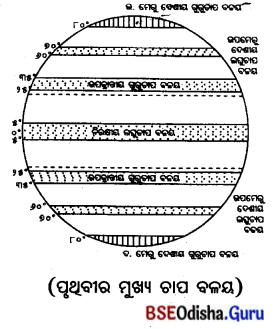
ବାୟୁ ପ୍ରବାହ :
- ବାୟୁ ସର୍ବଦା ଗୁରୁଚାପ ଅଞ୍ଚଳରୁ ଲଘୁଚାପ ଅଞ୍ଚଳକୁ ପ୍ରବାହିତ ହୋଇଥାଏ ।
- ଭୂପୃଷ୍ଠ ସହ ସମାନ୍ତର ଭାବେ ବହୁଥିବା ବାୟୁକୁ ପବନ ଏବଂ ନିମ୍ନମୁଖୀ ଓ ଉର୍ଦ୍ଧ୍ବ ମୁଖୀ ବାୟୁକୁ ବାୟୁସ୍ରୋତ କୁହାଯାଏ ।
- ବାୟୁପ୍ରବାହ ମୁଖ୍ୟତଃ ୪ ଶ୍ରେଣୀର ।
- ଗତିଶୀଳ ବାୟୁକୁ ପବନ କୁହାଯାଏ ।
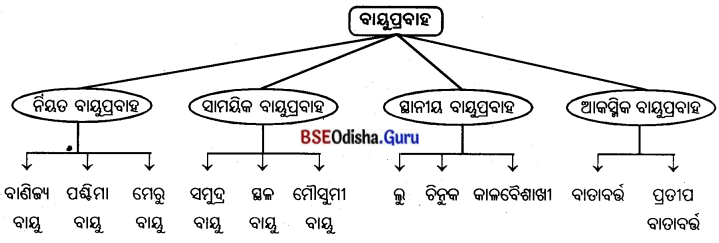
ବିଭିନ୍ନ ବାୟୁ ସମ୍ପର୍କରେ ଜାଣିବା :
ବାଣିଜ୍ୟ ବାୟୁ :
- ଉପକ୍ରାନ୍ତୀୟ ଗୁରୁଚାପ ବଳୟରୁ ନିରକ୍ଷୀୟ ଲଘୁଚାପ ବଳୟକୁ ପ୍ରବାହିତ ବାୟୁକୁ ବାଣିଜ୍ୟ ବାୟୁ ବା ଆୟନ ବାୟୁ କୁହାଯାଏ ।
- ଉତ୍ତର ଗୋଲାର୍ଦ୍ଧରେ ଉତ୍ତର-ପୂର୍ବ ଦିଗରୁ ପ୍ରବାହିତ ହେଉଥିବାରୁ ଏହାର ନାମ ଉତ୍ତର-ପୂର୍ବ ଆୟନ ବାୟୁ ଏବଂ ଦକ୍ଷିଣ ଗୋଲାର୍ଦ୍ଧରେ ଦକ୍ଷିଣ-ପୂର୍ବ ଦିଗରୁ ପ୍ରବାହିତ ହେଉଥିବାରୁ ଏହାକୁ ଦକ୍ଷିଣ- ପୂର୍ବ ଆୟନ ବାୟୁ କୁହାଯାଏ ।
ପଶ୍ଚିମା ବାୟୁ :
- ପଶ୍ଚିମା ବାୟୁ ଉଭୟ ଗୋଲାର୍ଦ୍ଧର ଉପକ୍ରାନ୍ତୀୟ ଗୁରୁଚାପ ବଳୟରୁ ଉପମେରୁ ଦେଶୀୟ ଲଘୁଚାପ ବଳୟକୁ ପ୍ରବାହିତ ହୁଏ ।
- ଉତ୍ତର ଗୋଲାର୍ଦ୍ଧରେ ଦକ୍ଷିଣ-ପଶ୍ଚିମ ଓ ଦକ୍ଷିଣ ଗୋଲାର୍ଦ୍ଧରେ ଉତ୍ତର-ପଶ୍ଚିମ ଦିଗରୁ ପ୍ରବାହିତ ହୁଏ ।
![]()
ମେରୁ ବାୟୁ :
- ମେରୁ ବାୟୁ ଉଭୟ ଗୋଲାର୍ଦ୍ଧର ମେରୁଦେଶୀୟ ଗୁରୁଚାପ ବଳୟରୁ ଉପମେରୁଦେଶୀୟ ଲଘୁଚାପ ବଳୟକୁ ପ୍ରବାହିତ ହୁଏ ।
- ଏହି ବାୟୁ ଉତ୍ତର ଗୋଲାର୍ଦ୍ଧରେ ଉତ୍ତର-ପୂର୍ବ ଦିଗରୁ ଏବଂ ଦକ୍ଷିଣ ଗୋଲାର୍ଦ୍ଧରେ ଦକ୍ଷିଣ-ପୂର୍ବ ଦିଗରୁ ପ୍ରବାହିତ ହୁଏ ।
ସମୁଦ୍ର ବାୟୁ : ସମୁଦ୍ରରୁ ସ୍ଥଳଭାଗକୁ ପ୍ରବାହିତ ବାୟୁକୁ ସମୁଦ୍ର ବାୟୁ କୁହାଯାଏ । ଏହା ପ୍ରାୟ ଦିନବେଳା ପ୍ରବାହିତ ହୋଇଥାଏ ।
ସ୍ଥଳ ବାୟୁ : ରାତିବେଳା ସ୍ଥଳଭାଗ ଜଳଭାଗ ଅପେକ୍ଷା ଶୀଘ୍ର ଥଣ୍ଡା ହୋଇ ଗୁରୁଚାପ ସୃଷ୍ଟି ହେଉଥିବାରୁ ସ୍ଥଳଭାଗରୁ ବାୟୁ ସମୁଦ୍ର ଆଡ଼କୁ ପ୍ରବାହିତ ହୁଏ । ଏହାକୁ ସ୍ଥଳବାୟୁ କୁହାଯାଏ ।
ଦକ୍ଷିଣ-ପଶ୍ଚିମ ମୌସୁମୀ ବାୟୁ : ଗ୍ରୀଷ୍ମକାଳରେ ଏସିଆ ଭୂଖଣ୍ଡରେ ଲଘୁଚାପ ସୃଷ୍ଟି ହେଉଥିବାରୁ ଏହି ମହାଦେଶର ଦକ୍ଷିଣରେ ଥିବା ମହାସାଗରରୁ ବାୟୁ ଦକ୍ଷିଣ-ପଶ୍ଚିମ ଦିଗରୁ ସ୍ଥଳଭାଗ ଆଡ଼କୁ ପ୍ରବାହିତ ହୁଏ ।
ଉତ୍ତର-ପୂର୍ବ ମୌସୁମୀ ବାୟୁ : ଶୀତଋତୁରେ ଜଳଭାଗ ଉପରେ ଲଘୁଚାପ ଓ ସ୍ଥଳଭାଗ ଉପରେ ଗୁରୁଚାପ ସୃଷ୍ଟିହେବା ଯୋଗୁଁ ସ୍ଥଳଭାଗରୁ ଶୁଷ୍କ ବାୟୁ ଉତ୍ତର-ପୂର୍ବ ଦିଗରୁ ପ୍ରବାହିତ ହୁଏ ।
ଳୁ : ଗ୍ରୀଷ୍ମକାଳରେ ଗାଙ୍ଗେୟ ସମତଳ ଅଞ୍ଚଳରେ ପ୍ରବାହିତ ଅତି ଉଷ୍ଣ ଓ ଶୁଷ୍କ ବାୟୁପ୍ରବାହ ‘କୁ’ ନାମରେ ପରିଚିତ ।
କାଳବୈଶାଖୀ : ଗ୍ରୀଷ୍ମଋତୁର ଅପରାହ୍ନରେ ଆସାମ, ପଶ୍ଚିମବଙ୍ଗ, ଉତ୍ତର ଓଡ଼ିଶାରେ ପ୍ରବାହିତ ଅତି ଉଷ୍ଣ ବାୟୁ ପ୍ରଭାବରେ ହେଉଥିବା ଘଡ଼ଘଡ଼ି ସହ ବୃଷ୍ଟିପାତକୁ କାଳବୈଶାଖୀ କୁହାଯାଏ ।
ଚିନୁକ୍ : ରକି ପାର୍ବତ୍ୟାଞ୍ଚଳରେ ଶୀତକାଳରେ ପ୍ରବାହିତ ଉଷ୍ଣ ଓ ଶୁଷ୍କ ବାୟୁକୁ ଚିନୁକ୍ କୁହାଯାଏ ।
ବାଟୀବର୍ଷ : ବାୟୁଚାପ ହଠାତ୍ ହ୍ରାସ ପାଇ କେନ୍ଦ୍ରୀଭୂତ ହେଲେ ସେ ସ୍ଥାନକୁ ଚତୁଃପାର୍ଶ୍ୱସ୍ଥ ଗୁରୁଚାପ ଅଞ୍ଚଳରୁ ବାୟୁ ତୀବ୍ର ବେଗରେ ପ୍ରବାହିତ ହୁଏ । ଏହା ଲଘୁଚାପ ଅଞ୍ଚଳକୁ ପ୍ରବେଶ କରି ନ ପାରି ଘୁରି ଘୂରି ଉପରକୁ ଉଠିଯାଏ । ଏହାକୁ ବାତାବର୍ଷ କୁହାଯାଏ ।
ପ୍ରତୀପ ବାତାବର୍ଷ : କୌଣସି ସ୍ଥାନରେ ବାୟୁଚାପ ହଠାତ୍ ବୃଦ୍ଧିପାଇ ଗୁରୁଚାପ କେନ୍ଦ୍ର ସୃଷ୍ଟି ହୁଏ ଓ ଏହି କେନ୍ଦ୍ରରୁ ବାୟୁ ଧୀରେ ଧୀରେ ଚତୁଃପାର୍ଶ୍ୱସ୍ଥ ଲଘୁଚାପ ଅଞ୍ଚଳକୁ ପ୍ରବାହିତ ହୁଏ । ଏହାକୁ ପ୍ରତୀପ ବାତାବର୍ଷ କୁହାଯାଏ ।
ବାୟୁର ଆର୍ଦ୍ରତା :
- ବାୟୁରେ ଜଳୀୟବାଷ୍ପର ଉପସ୍ଥିତି ଓ ପରିମାଣକୁ ବାୟୁର ଆର୍ଦ୍ରତା କୁହାଯାଏ ।
- ବାଷ୍ପୀଭୂତ ଜଳକଣାକୁ ଜଳୀୟବାଷ୍ପ କୁହାଯାଏ ।
- ବାଷ୍ପୀଭବନ ପ୍ରକ୍ରିୟାରେ ଭୂପୃଷ୍ଠର ଜଳରାଶି ଓ ତୁଷାର ରାଶିରୁ ଜଳ ବାଷ୍ପୀଭୂତ ହୋଇ ବାୟୁମଣ୍ଡଳରେ ମିଶେ ।
- ସେହିପରି ବାଷ୍ପମୋଚନ ପ୍ରକ୍ରିୟାରେ ବୃକ୍ଷଲତାଦିଙ୍କ ପତ୍ରରୁ ଜଳ ବାଷ୍ପୀଭୂତ ହୋଇଥାଏ ।
- ବାୟୁମଣ୍ଡଳରେ ଏହି ବାଷ୍ପୀଭୂତ ଜଳକଣା ବା ଜଳୀୟବାଷ୍ପ ବୃଷ୍ଟିପାତର କାରକ ଅଟେ ।
- ଉଚ୍ଚ ଅକ୍ଷାଂଶରେ ସୂର୍ଯ୍ୟତାପ କମ୍ ଯୋଗୁ ବାଷ୍ପୀଭବନର ହାର କମ୍, ମାତ୍ର ନିମ୍ନ ଅକ୍ଷାଂଶରେ ବାଷ୍ପୀଭବନ ପ୍ରକ୍ରିୟାର ହାର ଅଧିକ ।
- ତାପମାତ୍ରା ଅନୁଯାୟୀ ବାୟୁରେ କ୍ଷମତା ପରିମାଣର ଜଳୀୟବାଷ୍ପ ଥିଲେ ତାହା ପରିପୃକ୍ତ ବାୟୁ ଏବଂ କ୍ଷମତା ପରି ମାଣଠାରୁ କମ୍ ଜଳୀୟବାଷ୍ପ ଥିଲେ ତାହାକୁ ଅପରିପୃକ୍ତ ବାୟୁ କୁହାଯାଏ ।
- ବାଷ୍ପୀଭବନ ପ୍ରକ୍ରିୟା ଜଳର ସୁଲଭତା, ପବନର ବେଗ, ବାୟୁର ଶୁଷ୍କତା ଓ ସୂର୍ଯ୍ୟତାପର ପରିମାଣ ଉପରେ ନିର୍ଭର କରେ ।
- ହାଇଗ୍ଲୋମିଟର ଯନ୍ତ୍ର ଦ୍ବାରା ବାୟୁର ଆର୍ଦ୍ରତା ମପାଯାଏ ।
- ଘନୀଭବନ ପ୍ରକ୍ରିୟାରେ ଜଳୀୟବାଷ୍ପ ଗ୍ୟାସୀୟ ଅବସ୍ଥାରୁ ତରଳ ବା କଠିନ ଅବସ୍ଥାକୁ ଫେରିଆସେ ।
- ଶିଶିରାଙ୍କ ତାପମାତ୍ରାଠାରୁ ଘନୀଭବନ ପ୍ରକ୍ରିୟା ଆରମ୍ଭ ହୁଏ । ଫଳରେ କାକର, କୁହୁଡ଼ି, ମେଘ ଆଦି ସୃଷ୍ଟି ହୁଏ ।
- ଯେଉଁ ତାପମାତ୍ରାରେ ଜଳୀୟବାଷ୍ପ କ୍ଷୁଦ୍ର କ୍ଷୁଦ୍ର ଜଳକଣାରେ ପରିଣତ ହୁଏ, ତାହାକୁ ଶିଶିରାଙ୍କ କୁହାଯାଏ ।
![]()
ଘନୀଭବନର ପ୍ରରୂପ :
- ଘନୀଭବନ ପ୍ରକ୍ରିୟା ଫଳରେ କାକର, କୁହୁଡ଼ି, ମେଘ ଆଦି ସୃଷ୍ଟି ହୁଏ ।
- କାକର : ଶୀତରାତି ଓ ହେମନ୍ତ ଋତୁରେ ବାୟୁର ତାପମାତ୍ରା ଶିଶିରାଙ୍କ ତଳକୁ ଖସିଆସିଲେ ବାୟୁରେ ଥିବା ଜଳୀୟବାଷ୍ପ ଘନୀଭୂତ ହୋଇ କ୍ଷୁଦ୍ର କ୍ଷୁଦ୍ର ଜଳକଣାରେ ପରିଣତ ହୋଇଥାଏ। ଏହା ଶୀତଳ ପଦାର୍ଥ ବା ଘାସପତ୍ରରେ କାକର ରୂପେ ଲାଗିରହେ ।
- କୁହୁଡ଼ି : ଶୀତଋତୁରେ ଶୀତଳ ଭୂପୃଷ୍ଠକୁ ଲାଗିଥିବା ବାୟୁମଣ୍ଡଳ ଥଣ୍ଡା ହୋଇ ଶିଶିରାଙ୍କ ତଳକୁ ଖସିଆସିଲେ, ବାୟୁରେ ଥିବା ଜଳୀୟବାଷ୍ପ ଘନୀଭୂତ ହୁଏ । ଏହା ଧୂଳିକଣାକୁ ଆଶ୍ରୟ କରି ଭୂପୃଷ୍ଠର ଅଳ୍ପ ଉଚ୍ଚତାରେ ଭାସିବୁଲିଲେ ଏହାକୁ କୁହୁଡ଼ି କୁହାଯାଏ ।
- କୁହୁଡ଼ିର ପ୍ରକାରଭେଦ :
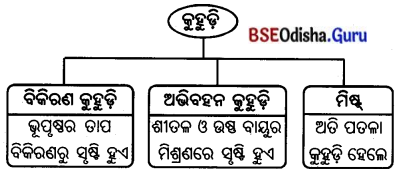
- ମେଘ : ଆକାଶରେ ଭାସମାନ ଅବସ୍ଥାରେ ଥିବା ଜଳକଣା ଓ ତୁଷାରକଣାର ସମାହାରକୁ ମେଘ କୁହାଯାଏ ।
ମେଘର ପ୍ରକାରଭେଦ :
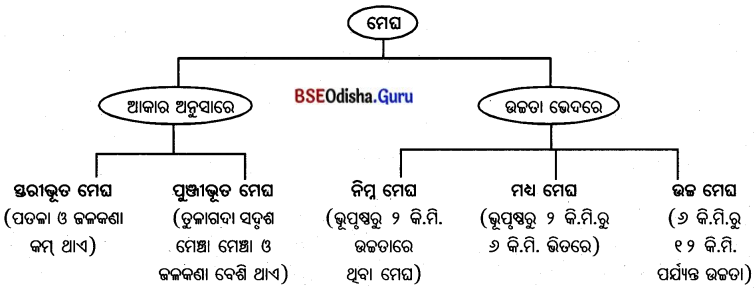
- ବର୍ଷଣ : ମେଘରେ ଥିବା ଜଳ କିମ୍ବା ତୁଷାରକଣା ଘନୀଭୂତ ହୋଇ ତଳକୁ ଖସିଲେ ଏହାକୁ ବର୍ଷଣ କୁହାଯାଏ ।
- ବୃଷ୍ଟିପାତ, ତୁଷାରପାତ ଏବଂ କରକାପାତ ଦ୍ବାରା ବର୍ଷଣ ପ୍ରକ୍ରିୟା ଘଟିଥାଏ ।
ବୃଷ୍ଟିପାତ :
- ମେଘରେ ଥିବା ଜଳକଣା ଘନୀଭୂତ ହୋଇ ଜଳ ଆକାରରେ ଭୂପୃଷ୍ଠରେ ପଡ଼ିବାକୁ ବୃଷ୍ଟିପାତ କୁହାଯାଏ ।
ବୃଷ୍ଟିପାତର ପ୍ରକାରଭେଦ :
- ପରିଚଳନ ବୃଷ୍ଟିପାତ ; ପରିଚଳନ ପ୍ରକ୍ରିୟାରେ ଉତ୍ତପ୍ତ ବାୟୁ ଉପରକୁ ଉଠି ପ୍ରସାରିତ ହୋଇ ଥଣ୍ଡା ହୁଏ । ଫଳରେ ଏଥିରେ ଥିବା ଜଳୀୟବାଷ୍ପ ଘନୀଭୂତ ହୋଇ ବିଜୁଳି ଓ ଘଡ଼ଘଡ଼ି ସହ ବୃଷ୍ଟି ହୁଏ ।
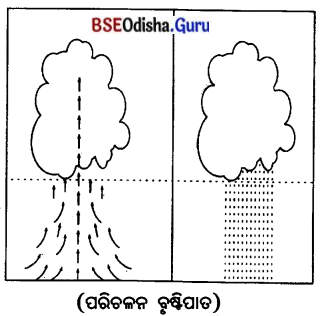
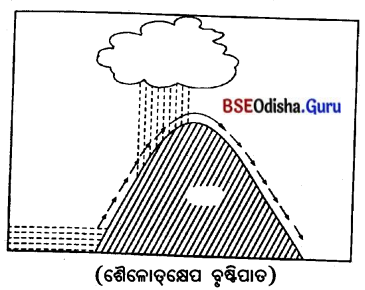
- ନିରକ୍ଷୀୟ ଅଞ୍ଚଳରେ ପ୍ରତିଦିନ ଅପରାହ୍ନରେ ପରିଚଳନ ବୃଷ୍ଟିପାତ ହୋଇଥାଏ ।
- ଶୈଳୋତ୍କ୍ଷେପ ବୃଷ୍ଟିପାତ : ଉଚ୍ଚ ପର୍ବତ ବା ଭୂମିରେ ଜଳୀୟବାଷ୍ପପୂର୍ଣ୍ଣ ବାୟୁ ବାଧାପାଇ ଉପରକୁ ଉଠେ ଓ ସେଠାରେ ପ୍ରସାରିତ ହୋଇ ଥଣ୍ଡା ହେବା ଫଳରେ ସେଥିରେ ଜଳୀୟବାଷ୍ପ ଘନୀଭୂତ ହୋଇ ପର୍ବତର ସେହି ପାର୍ଶ୍ବରେ ପ୍ରବଳ ବୃଷ୍ଟି କରାଏ ।
- ପର୍ବତର ଯେଉଁ ପାର୍ଶ୍ଵରେ ବାୟୁ ବାଧାପାଏ, ତାକୁ ପ୍ରତିବାତ ପାର୍ଶ୍ଵ ଓ ଏହାର ଅପର ପାର୍ଶ୍ଵକୁ ଅନୁବାତ ପାର୍ଶ୍ୱ କୁହାଯାଏ ।
- ବାତାବର୍ଷ ବୃଷ୍ଟିପାତ : କ୍ରାନ୍ତିମଣ୍ଡଳର ଅନ୍ତର୍ଗତ ସମୁଦ୍ର ଉପରେ ଲଘୁଚାପ କେନ୍ଦ୍ର ସୃଷ୍ଟି ହୁଏ । ଫଳରେ ଲଘୁଚାପ କେନ୍ଦ୍ରକୁ ପ୍ରବାହିତ ବାୟୁ ଘୂରି ଘୂରି ଉପରକୁ ଉଠିଯାଏ । ଏଥିରେ ଥିବା ଜଳୀୟବାଷ୍ପ ଘନୀଭୂତ ହୋଇ ପ୍ରବଳ ବର୍ଷା କରାଯାଏ ।
![]()
ତୁଷାରପାତ :
- ଉଚ୍ଚ ପର୍ବତଶ୍ରେଣୀ ବା ମାଳଭୂମି ଅଞ୍ଚଳରେ ହିମାଙ୍କଠାରୁ କମ୍ ତାପମାତ୍ରାରେ ବାୟୁରେ ଥିବା ଜଳକଣାଗୁଡ଼ିକ ତୁଷାରକଣାରେ ପରିଣତ ହୁଏ ଓ ଧଳା ଗୁଣ୍ଡ ଆକାରରେ ଭୂପୃଷ୍ଠରେ ପଡ଼େ ।
- କୁଆପଥର ବୃଷ୍ଟି : ଉତ୍ତପ୍ତ ବାୟୁସ୍ରୋତର ଉଗତି ଯୋଗୁ ମେଘ ହୁଏ ଓ ଏହା ଅତି ଉପରକୁ ଉଠିଗଲେ ଏଥରେ ଥିବା ଜଳକଣା ଓ ତୁଷାରକଣା ଜମାଟ ବାନ୍ଧି ଛୋଟ ବଡ଼ ବରଫଖଣ୍ଡରେ ପରିଣତ ହୋଇ ବୃଷ୍ଟିପାତ ସହ ଭୂପୃଷ୍ଠରେ ପଡ଼େ । ଏହାକୁ କୁଆପଥର ବୃଷ୍ଟି କହନ୍ତି ।
- କ୍ରାନ୍ତିମଣ୍ଡଳୀୟ ଅଞ୍ଚଳରେ ଖରାଦିନେ ଅପରାହ୍ନରେ କୁଆପଥର ବୃଷ୍ଟି ହୋଇଥାଏ ।
କେତେକ ଭୌଗୋଳିକ ଶବ୍ଦାବଳୀ
- ବାୟୁମଣ୍ଡଳ : ଆମ ପୃଥିବୀକୁ ଚତୁର୍ଦ୍ଦିଗରେ ଘେରି ରହିଥିବା ଗ୍ୟାସୀୟ ବଳୟ ।
- ଟ୍ରପୋସ୍ଟିଅର : ହାରାହାରି ୧୨ କିଲୋମିଟର ଉଚ୍ଚତା ବିଶିଷ୍ଟ ବାୟୁମଣ୍ଡଳର ସର୍ବନିମ୍ନ ସ୍ତର |
- ଷ୍ଟ୍ରାଟୋସ୍ପିଅର : ଟ୍ରପୋସ୍ପିଅର ଉପରକୁ ପ୍ରାୟ ୫୦ କି.ମି. ଉଚ୍ଚତା ପର୍ଯ୍ୟନ୍ତ ବ୍ୟାପିଥୁବା ବାୟୁ ସ୍ତର ।
- ଟ୍ରପୋପଜ୍ : ଟ୍ରପୋସ୍ପିଅର ଓ ଷ୍ଟ୍ରାଟୋସ୍ପିଅର ମଝିରେ ଥିବା ଏକ ପତଳା ବଳୟ ।
- ଷ୍ଟ୍ରାଟୋପଜ୍ : ଷ୍ଟ୍ରାଟୋସ୍ପିଅର ଓ ମେସୋସ୍ପିଅର ମଝିରେ ଥିବା ଏକ ପତଳା ବଳୟ ।
- ମେସୋପଜ୍ : ମେସୋସ୍ପିଅର୍ ଓ ଥର୍ମୋସ୍ପିଅରକୁ ପୃଥକ୍ କରୁଥୁବା ଏକ ପତଳା ବଳୟ ।
- ମେସୋସ୍ଟି ଅର୍ : ଷ୍ଟ୍ରାଟୋସ୍ପିଅର ଉପରକୁ ପ୍ରାୟ ୮୦ କି.ମି. ଉଚ୍ଚତା ବ୍ୟାପୀ ଥିବା ବାୟୁ ସ୍ତର ।
- ଥର୍ମୋସ୍ତି ଅର୍ : ମେସୋସ୍ଟି ଅରର ଉପର ସ୍ତରକୁ ଥର୍ମୋସ୍ତି ଅର କୁହାଯାଏ ।
- ଆୟୋନସ୍ପିଅର୍ : ଥର୍ମୋସ୍ପିଅରର ନିମ୍ନାଶ ଅର୍ଥାତ୍ ୮୦ରୁ ୪୦୦ କି.ମି. ପର୍ଯ୍ୟନ୍ତ ବିସ୍ତୃତ ବାୟୁ ସ୍ତର ।
- ଏକ୍ସ୍ଟି ଅର : ବାୟୁମଣ୍ଡଳର ବାହ୍ୟ ସ୍ତର ।
- ପାଣିପାଗ : ନିର୍ଦ୍ଦିଷ୍ଟ ସମୟରେ କୌଣସି ସ୍ଥାନର ବାୟୁମଣ୍ଡଳର ସାମୟିକ ଅବସ୍ଥା ।
- ଜଳବାୟୁ : କୌଣସି ସ୍ଥାନର ପାଣିପାଗର ବହୁବର୍ଷ ଧରି ହାରାହାରି ଅବସ୍ଥା ।
- ଉଷ୍ଠ ସ୍ରୋତ : ବିଷୁବ ଅଞ୍ଚଳରୁ ମେରୁ ଅଞ୍ଚଳକୁ ପ୍ରବାହିତ ସ୍ରୋତକୁ ଉସ୍ରୋତ କୁହାଯାଏ ।
- ଶୀତଳ ସ୍ରୋତ : ମେରୁ ଅଞ୍ଚଳରୁ ବିଷୁବ ଅଞ୍ଚଳକୁ ପ୍ରବାହିତ ସ୍ରୋତ ।
- ସୌରାଭିତାପ ଭୂପୃଷ୍ଠରେ ସଂଗୃହୀତ ସୌରରଶ୍ମିର ପରିମାଣ ।
- ତାପ ବଜେଟ୍ : ଶକ୍ତି ସଂଗ୍ରହ ଓ ଶକ୍ତି ବିକିରଣ ମଧ୍ୟରେ ସମତା ରହିବାକୁ ତାପ ବଜେଟ୍ କୁହାଯାଏ ।
- ଦୈନିକ ତାପ ବ୍ୟବଧାନ : ଦୈନିକ ସର୍ବୋଚ୍ଚ ଓ ସର୍ବନିମ୍ନ ତାପମାତ୍ରା ମଧ୍ୟରେ ବ୍ୟବଧାନ ।
- ବାର୍ଷିକ ତାପଚକ୍ର : ବର୍ଷକ ମଧ୍ୟରେ ତାପମାତ୍ରାର କ୍ରମଶଃ ହ୍ରାସବୃଦ୍ଧି ।
- ବାର୍ଷିକ ତାପ ବ୍ୟବଧାନ : ବର୍ଷର ଉଷ୍ଣତମ ଏବଂ ଶୀତଳତମ ମାସ ଦ୍ବୟର ହାରାହାରି ତାପମାତ୍ରାର ବ୍ୟବଧାନ ।
- ଗ୍ରୀଷ୍ମମଣ୍ଡଳ/ ଉଷ୍ଣମଣ୍ଡଳ : କର୍କଟକ୍ରାନ୍ତି ଓ ମକରକ୍ରାନ୍ତିର ମଧ୍ୟବର୍ତୀ ଅଞ୍ଚଳ ।
- ନାତିଶୀତୋଷ ମଣ୍ଡଳ : ଉଭୟ ଗୋଲାର୍ଦ୍ଧରେ କ୍ରାନ୍ତିବୃତ୍ତଠାରୁ ମେରୁବୃତ୍ତ ପର୍ଯ୍ୟନ୍ତ ଅଞ୍ଚଳ ।
- ହିମମଣ୍ଡଳ : ଉଭୟ ଗୋଲାର୍ଦ୍ଧରେ ମେରୁବୃତ୍ତଠାରୁ ମେରୁ ମଧ୍ୟବର୍ତ୍ତୀ ଅଧିକ ତୀର୍ଯ୍ୟକ୍ କିରଣ ପଡ଼ୁଥିବା ଅଞ୍ଚଳ ।
- ମିଲିବାର : ବାୟୁଚାପ ମାପିବାରେ ବ୍ୟବହୃତ ଏକକ ।
- ନିରକ୍ଷ ଶାନ୍ତ ବଳୟ : ବିଷୁବ ବୃତ୍ତର ଉଭୟ ପାର୍ଶ୍ଵ ରେ ୫° ସମାକ୍ଷରେଖା ମଧ୍ୟବର୍ତୀ ଚାପ ବଳୟ ।
- ଉପକ୍ରାନ୍ତୀୟ ଶାନ୍ତ ବଳୟ : ଉଭୟ ଗୋଲାର୍ଦ୍ଧର ୨୫°ରୁ ୩୫° ସମାକ୍ଷରେଖା ମଧ୍ୟବର୍ତ୍ତୀ ଉପକ୍ରାନ୍ତୀୟ ଗୁରୁଚାପ ବଳୟ ।
![]()
- ପବନ : ଭୂପୃଷ୍ଠ ସହ ସମାନ୍ତର ଭାବେ ବହୁଥିବା ବାୟୁ ।
- ବାୟୁସ୍ରୋତ : ନିମ୍ନ ବା ଉର୍ଦୁମୁଖୀ ପ୍ରବାହିତ ବାୟୁ ।
- ଉଇଣ୍ଡଭେନ୍ : ବାୟୁର ଦିଗ ମାପକ ଯନ୍ତ୍ର ।
- ଆନିମୋମିଟର : ବାୟୁର ବେଗ ମାପକ ଯନ୍ତ୍ର ।
- ନିୟତ ବାୟୁ : ଗୁରୁଚାପ ବଳୟରୁ ଲଘୁଚାପ ବଳୟକୁ ପ୍ରବାହିତ ବାୟୁ ।
- ଆୟନ ବାୟୁ/ବାଣିଜ୍ୟ ବାୟୁ : ଉପକ୍ରାନ୍ତୀୟ ଗୁରୁଚାପ ବଳୟରୁ ନିରକ୍ଷୀୟ ଲଘୁଚାପ ବଳୟକୁ ପ୍ରବାହିତ ବାୟୁ ।
- ପଶ୍ଚିମା ବାୟୁ : ଉଭୟ ଗୋଲାର୍ଦ୍ଧରେ ଉପକ୍ରାନ୍ତୀୟ ଗୁରୁଚାପ ବଳୟରୁ ଉପମେରୁ ଦେଶୀୟ ଲଘୁଚାପ ବଳୟକୁ ପ୍ରବାହିତ ବାୟୁ ।
- ଗର୍ଜନଶୀଳ ଚାଳିଶା : ଦକ୍ଷିଣ ଗୋଲାର୍ଦ୍ଧରେ ବିସ୍ତୀର୍ଣ୍ଣ ଜଳରାଶି ମଧ୍ଯରେ ପ୍ରାୟ ୪୦ରୁ ୪୯° ସମାକ୍ଷରେଖା ମଧ୍ଯରେ ପ୍ରବଳ ବେଗରେ ପ୍ରବାହିତ ପଶ୍ଚିମା ବାୟୁ ।
- ମେରୁ ବାୟୁ : ଉଭୟ ଗୋଲାର୍ଦ୍ଧରେ ମେରୁ ଦେଶୀୟ ଗୁରୁଚାପ ବଳୟରୁ ଉପମେରୁ ଦେଶୀୟ ଲଘୁଚାପ ବଳୟକୁ ପ୍ରବାହିତ ବାୟୁ ।
- ସାମୟିକ ବାୟୁ : ଦିନ ବା ବର୍ଷର ସମୟ ଭିତ୍ତିରେ ପରସ୍ପର ବିପରୀତ ଦିଗରୁ ପ୍ରବାହିତ ବାୟୁ ।
- ସ୍ଥଳ ବାୟୁ : ସ୍ଥଳଭାଗରୁ ସମୁଦ୍ର ଆଡ଼କୁ ପ୍ରବାହିତ ବାୟୁ ।
- ସମୁଦ୍ର ବାୟୁ : ସମୁଦ୍ରରୁ ସ୍ଥଳଭାଗକୁ ପ୍ରବାହିତ ହେଉଥିବା ବାୟୁ ।
- ଦକ୍ଷିଣ-ପୂର୍ବ ମୌସୁମୀ ବାୟୁ : ଗ୍ରୀଷ୍ମକାଳରେ ଏସିଆ ମହାଦେଶର ଦକ୍ଷିଣରେ ଥିବା ବିସ୍ତୃତ ଜଳଭାଗରୁ ସ୍ଥଳଭାଗକୁ ଦକ୍ଷିଣ-ପଶ୍ଚିମ ଦିଗରୁ ପ୍ରବାହିତ ମୌସୁମୀ ବାୟୁ ।
- ଉତ୍ତର-ପୂର୍ବ ମୌସୁମୀ ବାୟୁ : ଶୀତଋତୁରେ ସ୍ଥଳଭାଗରୁ ଜଳଭାଗକୁ ପ୍ରବାହିତ ଶୁଷ୍କ ମୌସୁମୀ ବାୟୁ ।
- କାଳବୈଶାଖୀ : ଓଡ଼ିଶାର ଉତ୍ତରଭାଗ, ପଶ୍ଚିମବଙ୍ଗ, ଆସାମ, ବାଂଲାଦେଶରେ ଗ୍ରୀଷ୍ମଦିନେ ଅପରାହ୍ନରେ ଉଷ୍ଣ ବାୟୁପ୍ରବାହ ଫଳରେ ଘଡ଼ଘଡ଼ି ସହ ହେଉଥିବା ବୃଷ୍ଟିପାତ ।
- ଲୁ : ଗ୍ରୀଷ୍ମଦିନେ ଗାଙ୍ଗେୟ ସମତଳ ଅଞ୍ଚଳ ତଥା ରାଜସ୍ଥାନରେ ପ୍ରବାହିତ ହେଉଥିବା ଏକ ଅତି ଉଷ୍ଣ ଓ ଶୁଷ୍କ ବାୟୁ ।
- ଚିନୁକ୍ : ରକି ପର୍ବତମାଳାର ପୂର୍ବ ଢାଲୁ ଅଞ୍ଚଳରେ ଶୀତକାଳରେ ପ୍ରବାହିତ ଏକ ଉଷ୍ଣ ଓ ଶୁଷ୍କ ବାୟୁ ।
- ବାୟୁର ଆର୍ଦ୍ରତା : ବାୟୁରେ ଜଳୀୟବାଷ୍ପର ପରିମାଣ ଓ ଉପସ୍ଥିତିକୁ ବାୟୁର ଆର୍ଦ୍ରତା କୁହାଯାଏ ।
- ଶିଶିରାଙ୍କ : ଯେଉଁ ତାପମାତ୍ରାରେ ଜଳୀୟବାଷ୍ପ କ୍ଷୁଦ୍ର କ୍ଷୁଦ୍ର ଜଳକଣାରେ ପରିଣତ ହୁଏ ।
- ବାଷ୍ପୀଭବନ : ଜଳ ଗ୍ୟାସୀୟ ଅବସ୍ଥାରେ ପରିବର୍ତ୍ତିତ ହେବା ପ୍ରକ୍ରିୟା ।
![]()
- ଘନୀଭବନ : ଜଳୀୟବାଷ୍ପ ଗ୍ୟାସୀୟ ଅବସ୍ଥାରୁ ତରଳ ବା କଠିନ ଅବସ୍ଥାକୁ ପରିବର୍ତ୍ତିତ ହେବା ପ୍ରକ୍ରିୟା ।
- ଅଭିବହନ କୁହୁଡ଼ି : ଶୀତଳ ବାୟୁ ଓ ଉଷ୍ଣ ଆର୍ଦ୍ର ବାୟୁର ମିଶ୍ରଣରେ ସୃଷ୍ଟି ହେଉଥିବା କୁହୁଡ଼ି ।
- ମିଷ୍ଟ୍ : କୁହୁଡ଼ି ଅତି ପତଳା ହେଲେ ତାହାକୁ ମିଷ୍ଟ୍ କୁହାଯାଏ ।
- ସ୍ତରୀଭୂତ ମେଘ : ଆକାଶରେ ବିସ୍ତୀର୍ଣ୍ଣ ଅଞ୍ଚଳରେ ସ୍ତର ସ୍ତର ହୋଇ ଭାସୁଥିବା ମେଘ ।
- ପୁଞ୍ଜିଭୂତ ମେଘ : ତୁଳାଗଦା ସଦୃଶ ମେଞ୍ଚା ମେଞ୍ଚା ହୋଇ ବହୁ ଉପରକୁ ଉଠି ରହି ଦେଖାଯାଉଥିବା ମେଘ ।
- ନିମ୍ନ ମେଘ : ଭୂପୃଷ୍ଠରୁ ପ୍ରାୟ ଦୁଇ କିଲୋମିଟର ପର୍ଯ୍ୟନ୍ତ ଉଚ୍ଚତାରେ ଥିବା ମେଘ ।
- ମଧ୍ୟ ମେଘ : ଦୁଇ କିଲୋମିଟରରୁ ୬ କିଲୋମିଟର ଉଚ୍ଚତା ପର୍ଯ୍ୟନ୍ତ ବିସ୍ତୃତ ହୋଇଥିବା ମେଘ ।
- ଉଚ୍ଚ ମେଘ : ୬ କି.ମି.ରୁ ୧୨ କି.ମି. ପର୍ଯ୍ୟନ୍ତ ବ୍ୟାପିଥିବା ମେଘ ।
- ବର୍ଷଣ : ମେଘରେ ଥିବା ଜଳ କିମ୍ବା ତୁଷାରକଣା ଘନୀଭୂତ ହୋଇ ତଳକୁ ଖସିବା ପ୍ରକ୍ରିୟା ।
- ରେଜ : ବୃଷ୍ଟିପାତର ପରିମାଣ ମାପ କରାଯାଉଥିବା ଯନ୍ତ୍ର ।
- ହାଇଗ୍ଲୋମିଟର : ବାୟୁର ଆର୍ଦ୍ରତା ମାପ କରାଯାଉଥିବା ଯନ୍ତ୍ର ।


